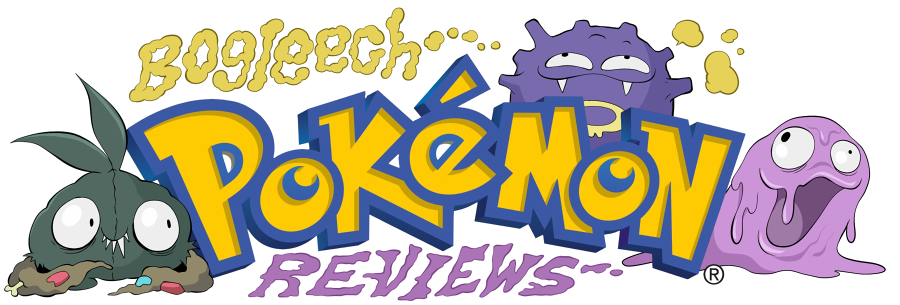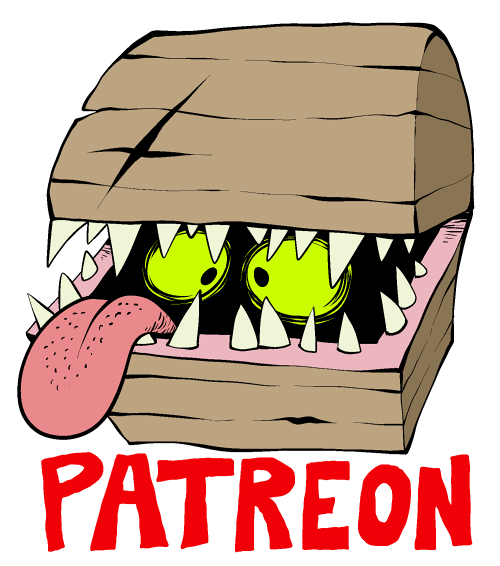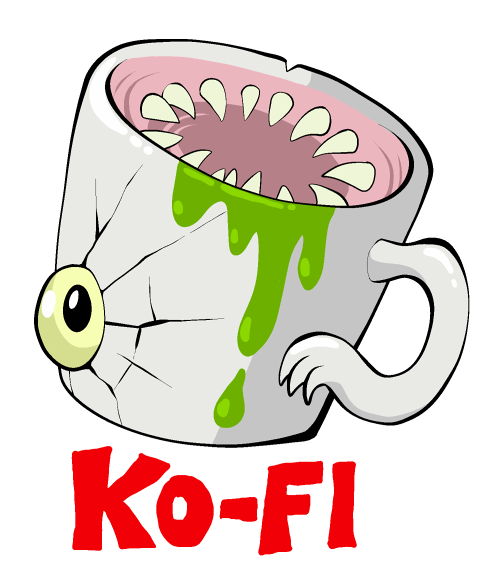100 ARTHROPODA BEGGING TO BE POKEMON
Yesterday, I lamented the fact that Sword and Shield are the first new games in the entire history of Pokemon to add no new insect, arachnid or crustacean genera to the franchise, something you may not care about, but I'm not exaggerating to say is something I personally care about more than just about anything else in pop culture. So, while putting together these reviews, I've also been assembling an ultimate list of the top hundred arthropoda that haven't been Pokemon yet. There's even some overlap here with an article I wrote many years ago, shortly before the fifth generation, which means even some of the most obvious choices have remained no-shows in the decade since. OUCH!
For each of these, I'll offer a quick example of what its Pokemon might be like. Obviously these won't always be professionally crafted concepts and I'm not drawing any of them, but they serve as an example of the sort of launching-point their concept could begin with.
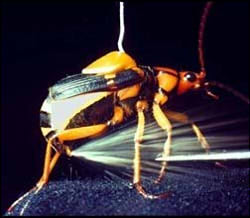
BOMBARDIER BEETLE:
We'll start with some of the Coleoptera. Many insects can spray some sort of chemical concoction as a defensive mechanism, but only the Bombardier Beetles unleash a formula that reaches 100 degrees celsius in the split second it leaves their flexible abdomen, and if the burning pain isn't enough, predators are easily deterred by how vile the sticky gunk tastes and smells. It's like a faceful of boiling hot pepper spray with a helping of skunk.
As a Pokemon: Bug/fire or bug/poison would be too easy. Maybe it could be some sort of freezing or electrifying compound, instead? What if it was a steel type that sprayed a mist of super-fine shrapnel or molten metal?
We'll start with some of the Coleoptera. Many insects can spray some sort of chemical concoction as a defensive mechanism, but only the Bombardier Beetles unleash a formula that reaches 100 degrees celsius in the split second it leaves their flexible abdomen, and if the burning pain isn't enough, predators are easily deterred by how vile the sticky gunk tastes and smells. It's like a faceful of boiling hot pepper spray with a helping of skunk.
As a Pokemon: Bug/fire or bug/poison would be too easy. Maybe it could be some sort of freezing or electrifying compound, instead? What if it was a steel type that sprayed a mist of super-fine shrapnel or molten metal?
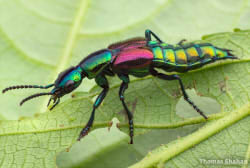
ROVE BEETLE:
One of the largest beetle groups, rove beetles tend to have long and very flexible bodies that can slink through small spaces in pursuit of prey, like the beetle version of a ferret. Some are semi-aquatic, some are poisonous, some are symbiotic with other animals and one group can launch its mouthparts on the end of a long, thin stalk!
As a Pokemon: make it even longer and slinkier than any real species, practically a snake-shaped beetle. Many species also tend to curl their abdomen over their head, which could lend itself to a beetle that rolls around like a hoop!
Photo by Thomas Shahan
One of the largest beetle groups, rove beetles tend to have long and very flexible bodies that can slink through small spaces in pursuit of prey, like the beetle version of a ferret. Some are semi-aquatic, some are poisonous, some are symbiotic with other animals and one group can launch its mouthparts on the end of a long, thin stalk!
As a Pokemon: make it even longer and slinkier than any real species, practically a snake-shaped beetle. Many species also tend to curl their abdomen over their head, which could lend itself to a beetle that rolls around like a hoop!
Photo by Thomas Shahan
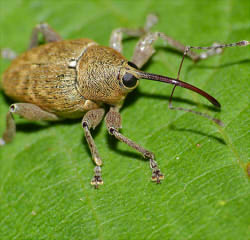
WEEVIL:
the very largest beetle group of all is also one of the most whimsical with most species possessing sad, dopey eyes and long, comical snouts. The tiny, tiny jaws are on the end of that proboscis, allowing them to drill holes in even the toughest-shelled nuts, seeds or rotten wood in which many varieties lay their eggs.
As a Pokemon: such a naturally cute insect would be good enough as a realistic, simple early-game bug, but I could also see a weevil that drills into rock the way the real things break through nuts. It could look like a little miner or spelunker, maybe even with a drill-like snout or pickaxe-like antennae.
Photo by Bernard Dupont
the very largest beetle group of all is also one of the most whimsical with most species possessing sad, dopey eyes and long, comical snouts. The tiny, tiny jaws are on the end of that proboscis, allowing them to drill holes in even the toughest-shelled nuts, seeds or rotten wood in which many varieties lay their eggs.
As a Pokemon: such a naturally cute insect would be good enough as a realistic, simple early-game bug, but I could also see a weevil that drills into rock the way the real things break through nuts. It could look like a little miner or spelunker, maybe even with a drill-like snout or pickaxe-like antennae.
Photo by Bernard Dupont

TIGER BEETLE:
Often extravagantly colorful and shiny, these predators are some of the fastest runners in nature. A tiger beetle runs so fast, in fact, that it is totally blind when moving; it has to point itself at prey, take off, and hope it hits its target.
As a Pokemon: we know the stats this one would focus on. Maybe the design could be shaped a little like a missile. Electric or fire elements could add a rocket-propulsion gimmick.
Photo by Katja Schulz
Often extravagantly colorful and shiny, these predators are some of the fastest runners in nature. A tiger beetle runs so fast, in fact, that it is totally blind when moving; it has to point itself at prey, take off, and hope it hits its target.
As a Pokemon: we know the stats this one would focus on. Maybe the design could be shaped a little like a missile. Electric or fire elements could add a rocket-propulsion gimmick.
Photo by Katja Schulz
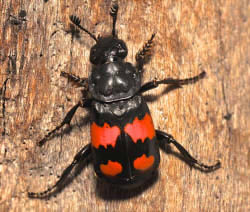
BURYING BEETLE:
these carrion eaters are so named because mated pairs work together to bury small, dead animals, mating for life and raising their larvae together in the miniature grave.
As a Pokemon: I had a specific concept for this one; it would be anthropomorphic and sexually dimorphic, which is something I've found stupid for some Pokemon, but here it would be so the beetles resemble a "Gomez and Morticia" sort of couple in funeral garb. To lighten their biology (as some Pokemon have done), I think they wouldn't bury corpses and eat them, but they would protect graveyards and raise their larvae on certain flowers that grow there. Wouldn't stop them from having an unfairly ghoulish reputation in-universe, though.
Photo by Pavel Kirillov
these carrion eaters are so named because mated pairs work together to bury small, dead animals, mating for life and raising their larvae together in the miniature grave.
As a Pokemon: I had a specific concept for this one; it would be anthropomorphic and sexually dimorphic, which is something I've found stupid for some Pokemon, but here it would be so the beetles resemble a "Gomez and Morticia" sort of couple in funeral garb. To lighten their biology (as some Pokemon have done), I think they wouldn't bury corpses and eat them, but they would protect graveyards and raise their larvae on certain flowers that grow there. Wouldn't stop them from having an unfairly ghoulish reputation in-universe, though.
Photo by Pavel Kirillov
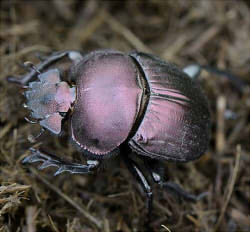
DUNG BEETLE:
Everyone knows dung beetles! They roll up perfect spheres of mammalian waste and push them around to impress their mates, eventually using the balls as incubators for their eggs.
As a Pokemon: they probably wouldn't make a Pokemon that really pushes feces around, but maybe they could go a humorously inverse route with a beetle that collects gold, diamonds and other treasure, perhaps even protecting old ruins from would-be grave robbers.
Photo by Charles J Sharp
Everyone knows dung beetles! They roll up perfect spheres of mammalian waste and push them around to impress their mates, eventually using the balls as incubators for their eggs.
As a Pokemon: they probably wouldn't make a Pokemon that really pushes feces around, but maybe they could go a humorously inverse route with a beetle that collects gold, diamonds and other treasure, perhaps even protecting old ruins from would-be grave robbers.
Photo by Charles J Sharp

DIVING BEETLE:
Diving beetles trap a bubble of air against their abdomens to continue breathing as they plunge underwater to hunt aquatic creatures such as tadpoles and tiny fish! Their fanged, venomous larvae are swimmers as well, and just as ferocious.
As a Pokemon: It would be easy to stylize one of these to look like a scuba diver with goggle-like eyes and flipper-like legs, or like a small submarine. A Galarian Pokemon already claims this idea, but using the larval stage as "torpedoes" would be fun too.
Photo by
Diving beetles trap a bubble of air against their abdomens to continue breathing as they plunge underwater to hunt aquatic creatures such as tadpoles and tiny fish! Their fanged, venomous larvae are swimmers as well, and just as ferocious.
As a Pokemon: It would be easy to stylize one of these to look like a scuba diver with goggle-like eyes and flipper-like legs, or like a small submarine. A Galarian Pokemon already claims this idea, but using the larval stage as "torpedoes" would be fun too.
Photo by

HARLEQUIN BEETLE:
The male Acrocinus longimanus has the widest leg span of any beetle in the world. Like the equally impressive "horns" of some other beetles, these are used to battle rival males during breeding season. Specifically, each beetle attempts to hook the other with its forelegs, swing them into the air and release them at just the right moment to send them soaring.
As a Pokemon:This insect really does look like a "harlequin," but it's also a strong-armed wrestler and its markings kind of remind me of a Luchador, a motif Pokemon already seems to love recycling. A harlequin-themed masked wrestler beetle, then??
Photo by Udo Schmidt
The male Acrocinus longimanus has the widest leg span of any beetle in the world. Like the equally impressive "horns" of some other beetles, these are used to battle rival males during breeding season. Specifically, each beetle attempts to hook the other with its forelegs, swing them into the air and release them at just the right moment to send them soaring.
As a Pokemon:This insect really does look like a "harlequin," but it's also a strong-armed wrestler and its markings kind of remind me of a Luchador, a motif Pokemon already seems to love recycling. A harlequin-themed masked wrestler beetle, then??
Photo by Udo Schmidt

OIL BEETLE:
The oil beetles, also called blister beetles. are another very large group. They tend to look remarkably similar to ants or wasps, but can be wildly colorful and sometimes sport these bizarrely massive abdomens. They get the name "oil beetle" and "blister beetle" from the defensive acid they secrete when irritated, and believe me, you do not want to google what that does to human skin. Please do not.
As a Pokemon: what about a bipedal, translucent beetle visibly filled with bubbling acid or boiling oil? Its entire shape could be evocative of a fancy old poison bottle.
Photo by Gail Hampshire
The oil beetles, also called blister beetles. are another very large group. They tend to look remarkably similar to ants or wasps, but can be wildly colorful and sometimes sport these bizarrely massive abdomens. They get the name "oil beetle" and "blister beetle" from the defensive acid they secrete when irritated, and believe me, you do not want to google what that does to human skin. Please do not.
As a Pokemon: what about a bipedal, translucent beetle visibly filled with bubbling acid or boiling oil? Its entire shape could be evocative of a fancy old poison bottle.
Photo by Gail Hampshire
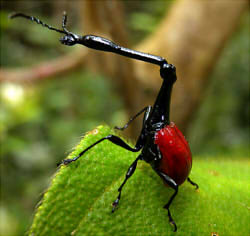
GIRAFFE WEEVIL:
unlike other weevils, this species put more length into its head and thorax than its mouthparts, giving it a ridiculously long "neck" with a single joint that the males use to compete with one another. After mating, they carefully roll up a leaf into a tube to protect their eggs.
As a Pokemon: It kind of looks like a construction crane, so that might be fun to play with. Its proboscis could be hook-shaped, and employed to move branches and logs that it uses to construct a nest.
Photo by Frank Vassen
unlike other weevils, this species put more length into its head and thorax than its mouthparts, giving it a ridiculously long "neck" with a single joint that the males use to compete with one another. After mating, they carefully roll up a leaf into a tube to protect their eggs.
As a Pokemon: It kind of looks like a construction crane, so that might be fun to play with. Its proboscis could be hook-shaped, and employed to move branches and logs that it uses to construct a nest.
Photo by Frank Vassen
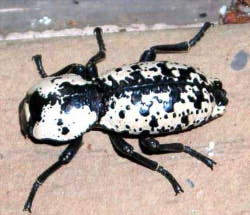
IRONCLAD BEETLE:
so named for having some of the thickest, toughest armor of all beetles. So tough, in fact, that a drill is required to get a pin through museum specimens. There's also an interesting, if possibly unkind practice in some places of gluing rhinestones to their shells and wearing them as living brooches.
As a Pokemon: Bug/steel is pretty tried and true. Referencing the real thing's use in fashion, the Pokemon version could enjoy collecting objects it uses to decorate its own shell and show off against its rivals.
Photo by Sqwertz
so named for having some of the thickest, toughest armor of all beetles. So tough, in fact, that a drill is required to get a pin through museum specimens. There's also an interesting, if possibly unkind practice in some places of gluing rhinestones to their shells and wearing them as living brooches.
As a Pokemon: Bug/steel is pretty tried and true. Referencing the real thing's use in fashion, the Pokemon version could enjoy collecting objects it uses to decorate its own shell and show off against its rivals.
Photo by Sqwertz
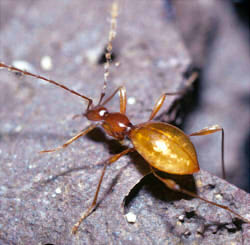
BLIND CAVE BEETLE:
there are eyeless, colorless, subterranean versions of many creatures on this list, but I think one of the coolest are these pale, almost ant-shaped beetles, which live as predators of other arthropods in absolute darkness.
As a Pokemon:I've wanted a troglobite Pokemon as long as this franchise has existed, and I'm not sure why they've never once taken advantage of the concept. Zubat was so close! Make a pale, ghostly cave beetle whose flaring antennae function like a bat's ears; maybe it even tunes in to the sonic calls of bat Pokemon, either to eat them or avoid being eaten.
there are eyeless, colorless, subterranean versions of many creatures on this list, but I think one of the coolest are these pale, almost ant-shaped beetles, which live as predators of other arthropods in absolute darkness.
As a Pokemon:I've wanted a troglobite Pokemon as long as this franchise has existed, and I'm not sure why they've never once taken advantage of the concept. Zubat was so close! Make a pale, ghostly cave beetle whose flaring antennae function like a bat's ears; maybe it even tunes in to the sonic calls of bat Pokemon, either to eat them or avoid being eaten.

FIRE BEETLE:
Several insects go by the common name "fire beetle," but this one is one of the "click beetles," named for their ability to flip themselves in the air by snapping their thorax against their abdomen. This species is unusual in producing bright light from two spots on its thorax, a pair of false eyes in the dark that may warn predators of its terrible taste.
As a Pokemon: I could imagine it having a thorax that looks like a menacing, monstrous face, but I could also see it looking like a little car with blinding "headlights" on its back.
Photo by Gilberto Santa Rosa
Several insects go by the common name "fire beetle," but this one is one of the "click beetles," named for their ability to flip themselves in the air by snapping their thorax against their abdomen. This species is unusual in producing bright light from two spots on its thorax, a pair of false eyes in the dark that may warn predators of its terrible taste.
As a Pokemon: I could imagine it having a thorax that looks like a menacing, monstrous face, but I could also see it looking like a little car with blinding "headlights" on its back.
Photo by Gilberto Santa Rosa
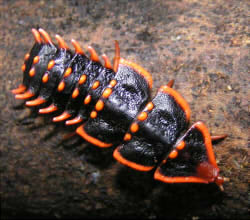
TRILOBITE BEETLE:
These have grown increasingly famous lately, but it's only the female that looks so much like a colorful trilobite. That's because she's an example of a "larviform" adult stage, the insect equivalent of an axolotl, reaching reproductive maturity without metamorphosis. The males undergo more conventional pupation into much smaller, more ordinary looking beetles, then take flight in search of those big, flat, colorful females like an airplane pilot zeroing in on a runway strip.
As a Pokemon: this should absolutely work just like Vespiquen, but with a swarm of little males parked on the giant-size trilobite female, whose colorful edges could even light up. Maybe they're all bug/electric, and she works like the "charging station."
Photo by Dave Dunford
These have grown increasingly famous lately, but it's only the female that looks so much like a colorful trilobite. That's because she's an example of a "larviform" adult stage, the insect equivalent of an axolotl, reaching reproductive maturity without metamorphosis. The males undergo more conventional pupation into much smaller, more ordinary looking beetles, then take flight in search of those big, flat, colorful females like an airplane pilot zeroing in on a runway strip.
As a Pokemon: this should absolutely work just like Vespiquen, but with a swarm of little males parked on the giant-size trilobite female, whose colorful edges could even light up. Maybe they're all bug/electric, and she works like the "charging station."
Photo by Dave Dunford

TORTOISE BEETLE:
I talked about these in my review of Orbeetle! They come in so many fantastically beautiful colors as adults, though their larvae, by contrast, are spiny grubs that cover themselves in their own droppings as a defensive weapon.
As a Pokemon: they love their "ugly ducklings" and Magikarp types, so this is a pretty good excuse for one. I feel like the adult stage would also be a fine place for a Pokemon with an excessive number of alternate forms ala Alcremie.
Photo by Katja Schulz
I talked about these in my review of Orbeetle! They come in so many fantastically beautiful colors as adults, though their larvae, by contrast, are spiny grubs that cover themselves in their own droppings as a defensive weapon.
As a Pokemon: they love their "ugly ducklings" and Magikarp types, so this is a pretty good excuse for one. I feel like the adult stage would also be a fine place for a Pokemon with an excessive number of alternate forms ala Alcremie.
Photo by Katja Schulz

GRASSHOPPER:
Can you believe there isn't a grasshopper Pokemon? For real? There are so many ways it could be done!
As a Pokemon: we tend to connect grasshopers with farms in our old cartoons, and even Japan seems to have that association. What if a grasshopper or locust Pokemon kind of looked like a cartoon scarecrow, and ironically protected rather than destroyed vegetable crops?
Photo by Boris Smokrovic
Can you believe there isn't a grasshopper Pokemon? For real? There are so many ways it could be done!
As a Pokemon: we tend to connect grasshopers with farms in our old cartoons, and even Japan seems to have that association. What if a grasshopper or locust Pokemon kind of looked like a cartoon scarecrow, and ironically protected rather than destroyed vegetable crops?
Photo by Boris Smokrovic
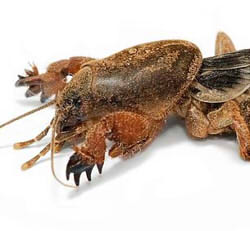
MOLE CRICKET:
Can you believe we don't have a grasshopper or a single proper cricket? Kricketune is a beetle, I might remind you. Mole crickets are so named for their burrowing lifestyle, with claws to match, and their odd appearance has earned them a role in a number of other Japanese gaming franchises, such as Digmon from Digimon, a collectible in Animal Crossing and oddly enough an NPC village in the Mother series, to name a few.
As a Pokemon: another I could see with a "mining" theme, perhaps with a light on its helmet-like head for good measure. I've also always wanted a star-nosed mole in Pokemon, but maybe they could give a mole cricket a star nose instead, which wouldn't feel out of place on an insect anyway.
Photo by Fir0002
Can you believe we don't have a grasshopper or a single proper cricket? Kricketune is a beetle, I might remind you. Mole crickets are so named for their burrowing lifestyle, with claws to match, and their odd appearance has earned them a role in a number of other Japanese gaming franchises, such as Digmon from Digimon, a collectible in Animal Crossing and oddly enough an NPC village in the Mother series, to name a few.
As a Pokemon: another I could see with a "mining" theme, perhaps with a light on its helmet-like head for good measure. I've also always wanted a star-nosed mole in Pokemon, but maybe they could give a mole cricket a star nose instead, which wouldn't feel out of place on an insect anyway.
Photo by Fir0002
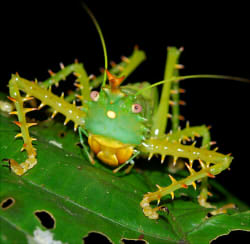
SPINY KATYDID:
a rainforest icon, this large katydid is famous for its prominent third eye as well as the menacing barbs covering its body. Katydids also tend to be omnivores or even predators, easily overwhelming other creatures with their strength, weight, and prickly limbs.
As a Pokemon: bug/psychic seems like a given here. Not just for the three eyes, but the reputation Katydids have for singing could translate to a hypnotizing musical attack.
Photo by Geoff Gallice
a rainforest icon, this large katydid is famous for its prominent third eye as well as the menacing barbs covering its body. Katydids also tend to be omnivores or even predators, easily overwhelming other creatures with their strength, weight, and prickly limbs.
As a Pokemon: bug/psychic seems like a given here. Not just for the three eyes, but the reputation Katydids have for singing could translate to a hypnotizing musical attack.
Photo by Geoff Gallice
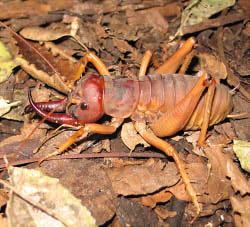
GIANT WETA:
The world's largest of all crickets live in New Zealand, having long lost their ability to fly and evolved in an ecosystem devoid of predatory shrews, rats or other major insect-hunters. Nearly driven to extinction, they've only made a comeback with a lot of human help.
As a Pokemon: since it's famous for being one of the world's largest insects, that should still ring true in the Pokemon world. Of course, since a bug type Pokemon can already be the size of a horse, we'd be talking a positively elephantine cricket here. Those mandibles even look a lot like tusks, don't they?
Photo by Chris Winks
The world's largest of all crickets live in New Zealand, having long lost their ability to fly and evolved in an ecosystem devoid of predatory shrews, rats or other major insect-hunters. Nearly driven to extinction, they've only made a comeback with a lot of human help.
As a Pokemon: since it's famous for being one of the world's largest insects, that should still ring true in the Pokemon world. Of course, since a bug type Pokemon can already be the size of a horse, we'd be talking a positively elephantine cricket here. Those mandibles even look a lot like tusks, don't they?
Photo by Chris Winks
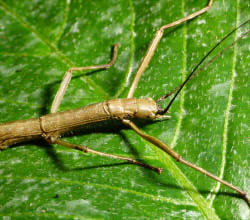
STICK INSECT:
Leavanny is already a leaf insect, another species of Phasmid, but we don't have a proper walkingstick to go with it! Some species even have functional thorns, and several can spray acid from their tail when they're angry enough.
As a Pokemon: posing as a grass type like Sudowoodo would be too obvious. My vote would go to a stick insect stylized like a wooden puppet, with a Pinocchio nose and raggedy "clothes" formed by clinging moss or lichen.
Photo by L. Shyamal
Leavanny is already a leaf insect, another species of Phasmid, but we don't have a proper walkingstick to go with it! Some species even have functional thorns, and several can spray acid from their tail when they're angry enough.
As a Pokemon: posing as a grass type like Sudowoodo would be too obvious. My vote would go to a stick insect stylized like a wooden puppet, with a Pinocchio nose and raggedy "clothes" formed by clinging moss or lichen.
Photo by L. Shyamal
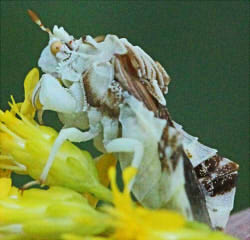
AMBUSH BUG:
This is our first entry in the Hemiptera, the insect group the word "bug" was originally meant to refer to! Ambush bugs are extremely tiny creatures, even smaller than your average fly, but they possess tough, spiny armor, knifelike front claws and beautiful colors that blend them in with the flowers and other colorful foliage on which they wait for prey.
As a Pokemon: I'd enjoy seeing a bug type with a bulky and truly fearsome physiology ala Pinsir, Drapion or Golisopod, but with an adorable floral pattern and false flower-like growths throughout. A terrifying enemy, but a loving protector to flower-type Pokemon.
Photo by Judy Gallagher
This is our first entry in the Hemiptera, the insect group the word "bug" was originally meant to refer to! Ambush bugs are extremely tiny creatures, even smaller than your average fly, but they possess tough, spiny armor, knifelike front claws and beautiful colors that blend them in with the flowers and other colorful foliage on which they wait for prey.
As a Pokemon: I'd enjoy seeing a bug type with a bulky and truly fearsome physiology ala Pinsir, Drapion or Golisopod, but with an adorable floral pattern and false flower-like growths throughout. A terrifying enemy, but a loving protector to flower-type Pokemon.
Photo by Judy Gallagher
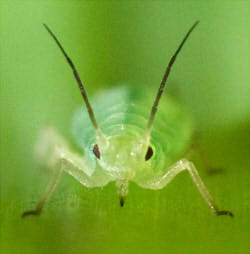
APHID:
These tiny plant pests are known for the alarming speed with which they reproduce and their sticky, nectar-like waste product, honeydew, which has even lead many species of ant to protect and "milk" aphids like cattle! Some species deviate from their usual look with long, feathery growths made from a natural wax, and in many species, the males have wings - but the females don't always need them, with the ability to "clone" themselves endlessly.
As a Pokemon: like Miltank and Chansey, an aphid Pokemon would probably produce honeydew with a healing effect on other creatures. Maybe it'd kind of look like a round little "potion bottle!"
Photo by
These tiny plant pests are known for the alarming speed with which they reproduce and their sticky, nectar-like waste product, honeydew, which has even lead many species of ant to protect and "milk" aphids like cattle! Some species deviate from their usual look with long, feathery growths made from a natural wax, and in many species, the males have wings - but the females don't always need them, with the ability to "clone" themselves endlessly.
As a Pokemon: like Miltank and Chansey, an aphid Pokemon would probably produce honeydew with a healing effect on other creatures. Maybe it'd kind of look like a round little "potion bottle!"
Photo by
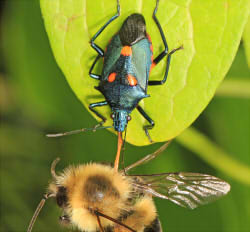
STINK BUG:
The most well known of the true bugs, famous for how terrible they smell when they're distressed and even worse when they're squashed. Like all true bugs, they can only feed on fluids through a single straw-like beak, but stinkbugs can be either herbivores or predators depending on the species!
As a Pokemon: it looks like a classic medeival shield and it defends itself by smelling bad. It's already as wacky as a Pokemon! I think it might be cute if its shieldlike back is stylized like some kind of metal danger sign as well, like a biohazard warning. Could it even have a face and body like a hazmat suit? PLEASE?
Photo by Judy Gallagher
The most well known of the true bugs, famous for how terrible they smell when they're distressed and even worse when they're squashed. Like all true bugs, they can only feed on fluids through a single straw-like beak, but stinkbugs can be either herbivores or predators depending on the species!
As a Pokemon: it looks like a classic medeival shield and it defends itself by smelling bad. It's already as wacky as a Pokemon! I think it might be cute if its shieldlike back is stylized like some kind of metal danger sign as well, like a biohazard warning. Could it even have a face and body like a hazmat suit? PLEASE?
Photo by Judy Gallagher
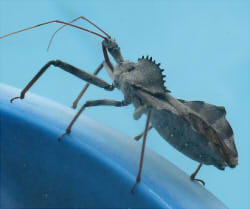
ASSASSIN BUG:
Our next true bug is an exclusively predatory group, often large and intimidating. All species can inject liquefying, paralyzing venom into their prey, but a few can even squirt it in a finely-aimed stream! There are also several who cover their own bodies in the remains of their prey or other camouflaging detritus.
As a Pokemon: Marowak and Mandibuzz aren't nearly enough bone-wearing Pokemon. Why not an assassin bug so armored in bones that it looks like a grim reaper, its wings forming a tattered black cloak and its proboscis like a scythe blade?
Photo by Marmelmm
Our next true bug is an exclusively predatory group, often large and intimidating. All species can inject liquefying, paralyzing venom into their prey, but a few can even squirt it in a finely-aimed stream! There are also several who cover their own bodies in the remains of their prey or other camouflaging detritus.
As a Pokemon: Marowak and Mandibuzz aren't nearly enough bone-wearing Pokemon. Why not an assassin bug so armored in bones that it looks like a grim reaper, its wings forming a tattered black cloak and its proboscis like a scythe blade?
Photo by Marmelmm
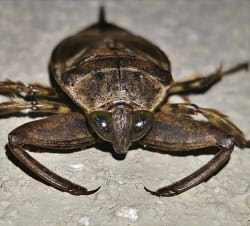
GIANT WATER BUG:
One of the largest of all the true bugs, the giant water bug doesn't bother collecting air like a diving beetle, but "snorkels" directly at the surface through its tail, resembling a dead leaf or a hunk of tree bark in the water as it waits to snatch passing prey in its knife-like claws. It can even paralyze fish several times its size!
As a Pokemon: I'd really want this to be the obvious bug/water Pokemon, but that's because I really like the idea of big hippo-sized giant water bugs floating around in a swamp, imitating rotten logs or stones and basically filling a niche identical to crocodilians. Perfect for regions that have a lot of fresh water, but no logical reason to have 'gators!
One of the largest of all the true bugs, the giant water bug doesn't bother collecting air like a diving beetle, but "snorkels" directly at the surface through its tail, resembling a dead leaf or a hunk of tree bark in the water as it waits to snatch passing prey in its knife-like claws. It can even paralyze fish several times its size!
As a Pokemon: I'd really want this to be the obvious bug/water Pokemon, but that's because I really like the idea of big hippo-sized giant water bugs floating around in a swamp, imitating rotten logs or stones and basically filling a niche identical to crocodilians. Perfect for regions that have a lot of fresh water, but no logical reason to have 'gators!
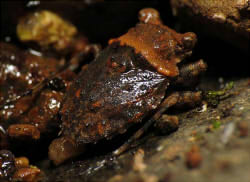
TOAD BUG:
This REALLY looks like a frog or toad from a distance, doesn't it?! But if you look closely, perhaps you can tell this is actually in the same exact family as the Giant Water Bug up there. This is basically a "water bug" that came back out of the water, no longer capable of swimming, but still found along the shores of ponds and streams where it blends in with stones and pounces on small prey.
As a Pokemon: perhaps this is a shoe-in for the unevolved form of the water bug, but either one has fun potential for a final stage. You can't go wrong with a bug that looks like a completely different animal and like a rock.
Photo by Katja Schulz
This REALLY looks like a frog or toad from a distance, doesn't it?! But if you look closely, perhaps you can tell this is actually in the same exact family as the Giant Water Bug up there. This is basically a "water bug" that came back out of the water, no longer capable of swimming, but still found along the shores of ponds and streams where it blends in with stones and pounces on small prey.
As a Pokemon: perhaps this is a shoe-in for the unevolved form of the water bug, but either one has fun potential for a final stage. You can't go wrong with a bug that looks like a completely different animal and like a rock.
Photo by Katja Schulz
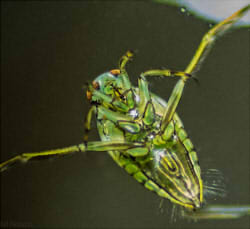
BACKSWIMMER:
Another wildly different cousin to the water bug, these smaller predators actually do trap air to stay submerged for longer periods, and while some are "water boatmen" who paddle around right-side up, the "backswimmers" swim upside-down to feed on insects that have fallen into the water...or attack water striders!
As a Pokemon: you ever see old cartoons where there's a flood, and someone uses a couple of brooms to paddle a bathtub around like a boat? That's totally what these insects remind me of, or at least like someone lazily relaxing in a little raft.
Photo by Olaf Nelson
Another wildly different cousin to the water bug, these smaller predators actually do trap air to stay submerged for longer periods, and while some are "water boatmen" who paddle around right-side up, the "backswimmers" swim upside-down to feed on insects that have fallen into the water...or attack water striders!
As a Pokemon: you ever see old cartoons where there's a flood, and someone uses a couple of brooms to paddle a bathtub around like a boat? That's totally what these insects remind me of, or at least like someone lazily relaxing in a little raft.
Photo by Olaf Nelson
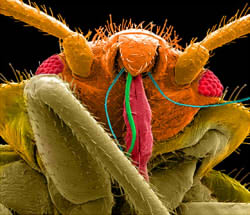
BED BUG:
Originally evolving in caves, these parasitic true bugs are as flat as confetti, hiding in crevices during the day to feed on blood from sleeping birds or mammals at night. Excessive pesticide use eventually made them so resilient that some people have just packed up and moved to get away from them!
As a Pokemon: they're a source of trauma to a lot of people, but bed bugs still make it into a lot of cartoons. What if a bedbug Pokemon used a man-made pillow like a hermit crab uses its shell? What if it were even another psychic-type dream-eating creature? Local Drowzee or Musharna populations may be plummeting as this invasive pest hogs their usual food supply.
Originally evolving in caves, these parasitic true bugs are as flat as confetti, hiding in crevices during the day to feed on blood from sleeping birds or mammals at night. Excessive pesticide use eventually made them so resilient that some people have just packed up and moved to get away from them!
As a Pokemon: they're a source of trauma to a lot of people, but bed bugs still make it into a lot of cartoons. What if a bedbug Pokemon used a man-made pillow like a hermit crab uses its shell? What if it were even another psychic-type dream-eating creature? Local Drowzee or Musharna populations may be plummeting as this invasive pest hogs their usual food supply.
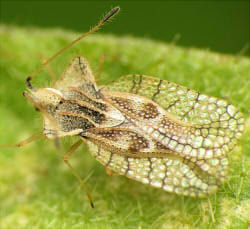
LACE BUG:
A mostly harmless, herbivorous true bug this time, though one capable of a mildly annoying defensive bite. Their gorgeously lacey, mostly transparent bodies make them particularly difficult for predators to see against the veiny surfaces of the leaves they feed upon.
As a Pokemon: this one I could see most as an elegant bug/fairy type, possibly resembling a humanoid in a wedding gown or even with a stained glass motif.
Photo by Katja Schulz
A mostly harmless, herbivorous true bug this time, though one capable of a mildly annoying defensive bite. Their gorgeously lacey, mostly transparent bodies make them particularly difficult for predators to see against the veiny surfaces of the leaves they feed upon.
As a Pokemon: this one I could see most as an elegant bug/fairy type, possibly resembling a humanoid in a wedding gown or even with a stained glass motif.
Photo by Katja Schulz
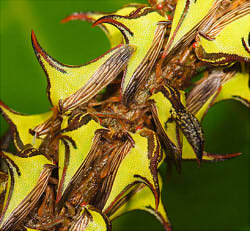
TREEHOPPER:
a huge group related to cicadas and lanternflies, the treehoppers, leafhoppers and planthoppers are cute, colorful little creatures that can launch themselves like bullets and even take flight. Several species are also famous for perfectly imitating thorns, and some have extremely complex, weird growths on their heads.
As a Pokemon: I think the thorn-mimicking species would be the most likely to catch their eye, while its evolved form could have horns that keep going into a whole prickly hedge of false branches and vines.
Photo by Marshal Hedin
a huge group related to cicadas and lanternflies, the treehoppers, leafhoppers and planthoppers are cute, colorful little creatures that can launch themselves like bullets and even take flight. Several species are also famous for perfectly imitating thorns, and some have extremely complex, weird growths on their heads.
As a Pokemon: I think the thorn-mimicking species would be the most likely to catch their eye, while its evolved form could have horns that keep going into a whole prickly hedge of false branches and vines.
Photo by Marshal Hedin
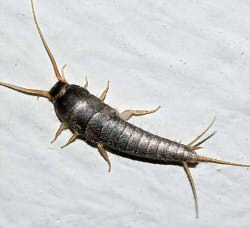
SILVERFISH:
I'd say these were recently popularized by Minecraft, but there's a trend of Minecraft players expressing shock that a silverfish is actually a real insect. Extremely ancient, they're best known for feeding on paper and cardboard, making them pests wherever books and documents are stored.
As a Pokemon: my own fan region has a silverfish that eats metal, Pokemon's take on a Rust Monster. Bug/steel would be too obvious, though; I prefer to think it would be pure bug, but with a signature move designed to hurt defensive steel types.
Photo by Christian Fischer
I'd say these were recently popularized by Minecraft, but there's a trend of Minecraft players expressing shock that a silverfish is actually a real insect. Extremely ancient, they're best known for feeding on paper and cardboard, making them pests wherever books and documents are stored.
As a Pokemon: my own fan region has a silverfish that eats metal, Pokemon's take on a Rust Monster. Bug/steel would be too obvious, though; I prefer to think it would be pure bug, but with a signature move designed to hurt defensive steel types.
Photo by Christian Fischer
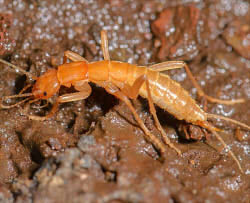
ICE CRAWLER:
these are some of the rare few insects that live directly on ice and snow, including perpetually frozen caves! They feed on almost any organic matter, which often includes the frozen bodies of less adaptable invertebrates.
As a Pokemon: the real thing is a bit plain, but that would work well for the Pokemon version anyway; a thin, simple looking bug covered in a more impressive armor of transparent ice. Maybe it could just be pure bug type, but with an ability that makes it both immune to ice damage and strengthens its own use of ice moves?
Photo by Marshal Hedin.
these are some of the rare few insects that live directly on ice and snow, including perpetually frozen caves! They feed on almost any organic matter, which often includes the frozen bodies of less adaptable invertebrates.
As a Pokemon: the real thing is a bit plain, but that would work well for the Pokemon version anyway; a thin, simple looking bug covered in a more impressive armor of transparent ice. Maybe it could just be pure bug type, but with an ability that makes it both immune to ice damage and strengthens its own use of ice moves?
Photo by Marshal Hedin.
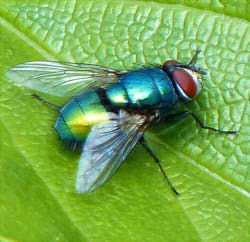
BLOWFLY:
A blowfly or any Dipteran with that classic fly aesthetic remains my #1 most-wanted bug Pokemon. They're some of nature's most important scavengers, they have that delightful proboscis like nothing else in nature, and I've never gotten over the personality conveyed by those huge, huge eyes.
As a Pokemon: I've come up with too many fly Pokemon to count, but I'd really just like to see another good old bug/poison type. A fly's face would be easy to stylize into a gas mask, too, which I've also discussed before as imagery sorely missing from Pokemon designs.
Photo by Badobadop
A blowfly or any Dipteran with that classic fly aesthetic remains my #1 most-wanted bug Pokemon. They're some of nature's most important scavengers, they have that delightful proboscis like nothing else in nature, and I've never gotten over the personality conveyed by those huge, huge eyes.
As a Pokemon: I've come up with too many fly Pokemon to count, but I'd really just like to see another good old bug/poison type. A fly's face would be easy to stylize into a gas mask, too, which I've also discussed before as imagery sorely missing from Pokemon designs.
Photo by Badobadop
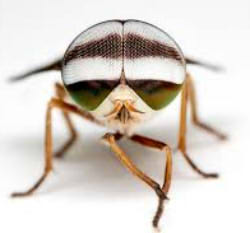
HORSEFLY:
The biting cousins of those gentle garbage-eaters. It's not even that a horsefly "sucks blood" exactly; their bites hurt so much because they carve out a whole little chunk of flesh, and will even fly away with it! YOU PUT THAT BACK!!!
As a Pokemon: perfect for bug/dark. Their psychedelically colorful eyes would make a really standout design feature, and as much as I like the proboscis (which almost looks like a pair of rat teeth in some species) I'd kind of expect the Pokemo to have a big, saw-toothed mouth, like a cookie-cutter shark or like Baikinman.
The biting cousins of those gentle garbage-eaters. It's not even that a horsefly "sucks blood" exactly; their bites hurt so much because they carve out a whole little chunk of flesh, and will even fly away with it! YOU PUT THAT BACK!!!
As a Pokemon: perfect for bug/dark. Their psychedelically colorful eyes would make a really standout design feature, and as much as I like the proboscis (which almost looks like a pair of rat teeth in some species) I'd kind of expect the Pokemo to have a big, saw-toothed mouth, like a cookie-cutter shark or like Baikinman.
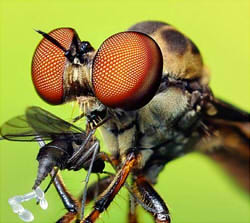
ROBBER FLY:
I've seen these called the "eagles of the insect world" a couple times, but eagles typically only eat things smaller than themselves. A robber fly will attack everything from the tiniest gnat to dragonflies, hornets and spiders twice its mass, and almost always win, aided by a mustache-like row of spines that protect its face from the jaws or stingers of trickier prey.
As a Pokemon: another bug/dark contender, but perhaps even bug/dragon would make sense here, or a bug type striped black and white like an actual "robber."
Photo by Thomas Shahan
I've seen these called the "eagles of the insect world" a couple times, but eagles typically only eat things smaller than themselves. A robber fly will attack everything from the tiniest gnat to dragonflies, hornets and spiders twice its mass, and almost always win, aided by a mustache-like row of spines that protect its face from the jaws or stingers of trickier prey.
As a Pokemon: another bug/dark contender, but perhaps even bug/dragon would make sense here, or a bug type striped black and white like an actual "robber."
Photo by Thomas Shahan
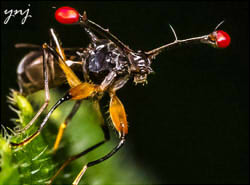
STALK EYED FLY:
This is a strictly fruit-eating fly that never bothers anybody, except for its own kind; males use their long eyestalks to fight over females, pressing their heads together and comparing their eye width. The wider head wins, but at a cost: the longer the stalks, the worse they are at flying, which means some males are too desirable to pass on their offspring with a high success rate.
As a Pokemon: why are there virtually NO Pokemon with eyes on elongated stalks? None? One of the most beloved and interesting features of countless animals?! That's actually all I have to say here. Just do it.
Photo by Yogendra Joshi
This is a strictly fruit-eating fly that never bothers anybody, except for its own kind; males use their long eyestalks to fight over females, pressing their heads together and comparing their eye width. The wider head wins, but at a cost: the longer the stalks, the worse they are at flying, which means some males are too desirable to pass on their offspring with a high success rate.
As a Pokemon: why are there virtually NO Pokemon with eyes on elongated stalks? None? One of the most beloved and interesting features of countless animals?! That's actually all I have to say here. Just do it.
Photo by Yogendra Joshi
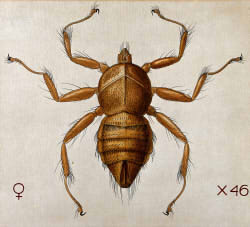
BAT FLY:
this is just one example of a whole group of blood-sucking flies that completely lost their wings. In this case, the long legs help cling to their bat hosts!
As a Pokemon: it may seem like too obscure an insect, but a photo of a bat fly clinging to a bat's head has been going pretty viral for a few years, and Gamefreak keeps putting highly specific insects in their games once they've circulated Instagram enough times. What about a bug/flying Pokemon consisting of both the bat and the insect, the latter large enough to wrap around its host and function as armor?
this is just one example of a whole group of blood-sucking flies that completely lost their wings. In this case, the long legs help cling to their bat hosts!
As a Pokemon: it may seem like too obscure an insect, but a photo of a bat fly clinging to a bat's head has been going pretty viral for a few years, and Gamefreak keeps putting highly specific insects in their games once they've circulated Instagram enough times. What about a bug/flying Pokemon consisting of both the bat and the insect, the latter large enough to wrap around its host and function as armor?

FLEA:
Another of my all-time most wanted. Everybody knows what fleas are! They're totally flightless, but one of nature's most fantastic leapers, and they just look so dang cool.
As a Pokemon: this could be the new tiniest Pokemon of all time, barely visible at all in-game, but with surprising speed and offenses or at least some pretty debilitating status attacks.
Another of my all-time most wanted. Everybody knows what fleas are! They're totally flightless, but one of nature's most fantastic leapers, and they just look so dang cool.
As a Pokemon: this could be the new tiniest Pokemon of all time, barely visible at all in-game, but with surprising speed and offenses or at least some pretty debilitating status attacks.
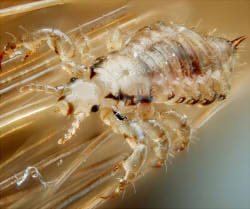
LOUSE:
You know, there's a LOT of fleas in cartoons, but almost never lice. It seems like people actually find lice a whole lot more "disgusting" than fleas, perhaps because fleas have the courtesy to jump back off of us while lice actually lay eggs in our hair? They're cute, though, with their pudgy limbs and beady eyes.
As a Pokemon: associated with hair and once a major problem in barbershops, a louse Pokemon could have scissors for arms and a red and white striped motif. As the origin of the term "cooties," it could also be a cute fairy-type bug with a sort of Valentine's Day style to it, its bite making other creatures "lovestruck" while it makes an escape.
Photo by Gilles San Martin
You know, there's a LOT of fleas in cartoons, but almost never lice. It seems like people actually find lice a whole lot more "disgusting" than fleas, perhaps because fleas have the courtesy to jump back off of us while lice actually lay eggs in our hair? They're cute, though, with their pudgy limbs and beady eyes.
As a Pokemon: associated with hair and once a major problem in barbershops, a louse Pokemon could have scissors for arms and a red and white striped motif. As the origin of the term "cooties," it could also be a cute fairy-type bug with a sort of Valentine's Day style to it, its bite making other creatures "lovestruck" while it makes an escape.
Photo by Gilles San Martin
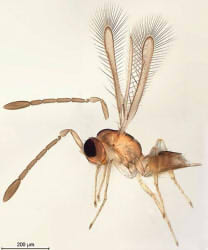
FAIRY FLY:
the tiniest of all insects, in some cases smaller than even single-celled protozoa and utterly invisible without a microscope! They're actually a type of wasp, and a parasitoid in the eggs of other insects.
As a Pokemon: everything I said about the flea could alternatively apply here. Maybe this would be too distressing for some players, but what if eggs from other bug-type Pokemon had a chance to hatch into one of these, perhaps by location?
Photo by George Poinar & John T. Huber
the tiniest of all insects, in some cases smaller than even single-celled protozoa and utterly invisible without a microscope! They're actually a type of wasp, and a parasitoid in the eggs of other insects.
As a Pokemon: everything I said about the flea could alternatively apply here. Maybe this would be too distressing for some players, but what if eggs from other bug-type Pokemon had a chance to hatch into one of these, perhaps by location?
Photo by George Poinar & John T. Huber
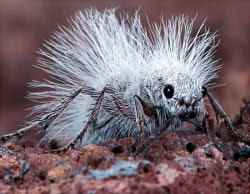
VELVET ANT:
This is another parasitoid wasp, but the colorful and wingless females look very much like fuzzy ants. They actually have one of the most painful stings known to man, earning some species the common name "Cow Killer!" Their exoskeleton is unbelievably strong, too; I've personally tested it with dead ones, and it's like a tiny hunk of stone. It's virtually uncrushable!
As a Pokemon: a cute, fluffy little bug type with a stinging attack that almost always critical hits, lowers enemy stats, ignores defenses, paralyzes or any combination of the above.
This is another parasitoid wasp, but the colorful and wingless females look very much like fuzzy ants. They actually have one of the most painful stings known to man, earning some species the common name "Cow Killer!" Their exoskeleton is unbelievably strong, too; I've personally tested it with dead ones, and it's like a tiny hunk of stone. It's virtually uncrushable!
As a Pokemon: a cute, fluffy little bug type with a stinging attack that almost always critical hits, lowers enemy stats, ignores defenses, paralyzes or any combination of the above.
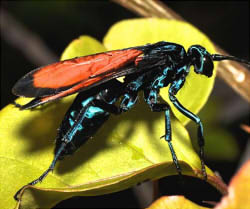
TARANTULA HAWK:
One more parasitoid wasp! Fallout fans recognize this all too well. The Tarantula Hawk is so named because it paralyzes spiders many times its own size, dragging them back to its nest as nourishment for its larvae, and while not usually interested in humans, you don't want to experience that sting yourself.
As a Pokemon: another contender for bug/dragon? But perhaps that's being "too obvious" again. In any case, we could really use a real wasp Pokemon that's not just a black and white striped "bee" or "hornet."
Photo by Pavel Kirillov
One more parasitoid wasp! Fallout fans recognize this all too well. The Tarantula Hawk is so named because it paralyzes spiders many times its own size, dragging them back to its nest as nourishment for its larvae, and while not usually interested in humans, you don't want to experience that sting yourself.
As a Pokemon: another contender for bug/dragon? But perhaps that's being "too obvious" again. In any case, we could really use a real wasp Pokemon that's not just a black and white striped "bee" or "hornet."
Photo by Pavel Kirillov
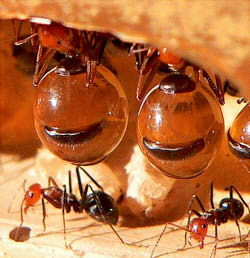
HONEYPOT ANT:
A real actual ant this time. Honeypot ants are unusual in that a certain caste acts as living food storage, their abdomens swelling to enormous size with sweet, sugary nectar they can extrude at the request of their sisters.
As a Pokemon: this one already has Pokemon written all over it, how cute would a cartoon ant be with a big jar of honey for a body, or sitting on its own literal honey pot abdomen? You could even put a nozzle on its head like those honey bears you get at the grocery store!
Photo by Greg Hume
A real actual ant this time. Honeypot ants are unusual in that a certain caste acts as living food storage, their abdomens swelling to enormous size with sweet, sugary nectar they can extrude at the request of their sisters.
As a Pokemon: this one already has Pokemon written all over it, how cute would a cartoon ant be with a big jar of honey for a body, or sitting on its own literal honey pot abdomen? You could even put a nozzle on its head like those honey bears you get at the grocery store!
Photo by Greg Hume
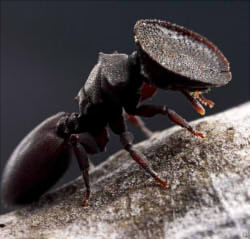
TURTLE ANT:
One more unusual ant we can fit in here belongs to the genus Cephalotes, and some soldiers exhibit a flat, circular head shield they use to plug up the entryway to the nest. Several species in the genus are also streamlined in such a way that they can glide when they drop from a tree branch.
As a Pokemon: there are so many fun things you could do with that head disk, but it reminds me the most of a manhole cover. You could have a grumpy little "sewer worker" ant with a manhole cover head, and its underground colonies are designed to divert water that irrigates their food crops!
Photo by Alex Wild
One more unusual ant we can fit in here belongs to the genus Cephalotes, and some soldiers exhibit a flat, circular head shield they use to plug up the entryway to the nest. Several species in the genus are also streamlined in such a way that they can glide when they drop from a tree branch.
As a Pokemon: there are so many fun things you could do with that head disk, but it reminds me the most of a manhole cover. You could have a grumpy little "sewer worker" ant with a manhole cover head, and its underground colonies are designed to divert water that irrigates their food crops!
Photo by Alex Wild
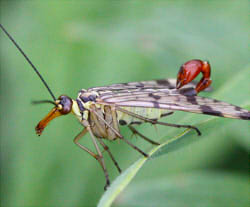
SCORPIONFLY:
Speaking of Fallout again, these appear in the series as "stingwings" even though the scorpion-like tail of the male isn't a weapon at all; it's the wingdangdoodle. Personally I'm more enamored with their colors and their long, thin "beaks," perfect for scavenging the corpses of other insects, which comprises most of their diet! They're insect vultures!
As a Pokemon: would they dare give only males the scorpion tail, knowing what it really means? Or would they pull a Fallout and just pretend it's a real stinger? In any case, maybe they could give it an even more buzzard-like shape.
Speaking of Fallout again, these appear in the series as "stingwings" even though the scorpion-like tail of the male isn't a weapon at all; it's the wingdangdoodle. Personally I'm more enamored with their colors and their long, thin "beaks," perfect for scavenging the corpses of other insects, which comprises most of their diet! They're insect vultures!
As a Pokemon: would they dare give only males the scorpion tail, knowing what it really means? Or would they pull a Fallout and just pretend it's a real stinger? In any case, maybe they could give it an even more buzzard-like shape.
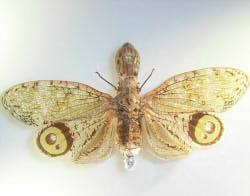
ALLIGATOR BUG:
a large species of lanternfly, this sap-sucking insect is camouflaged like tree bark, startles enemies with false eyespots, and sports a bizarre forehead growth likened to a false reptile-like head...or a peanut.
As a Pokemon: I suspected it was fake, but the fan-made Lanternfly Pokemon was a truly perfect design. Its real eyes even look like the actual bug's false ones!
Photo by Notafly
a large species of lanternfly, this sap-sucking insect is camouflaged like tree bark, startles enemies with false eyespots, and sports a bizarre forehead growth likened to a false reptile-like head...or a peanut.
As a Pokemon: I suspected it was fake, but the fan-made Lanternfly Pokemon was a truly perfect design. Its real eyes even look like the actual bug's false ones!
Photo by Notafly
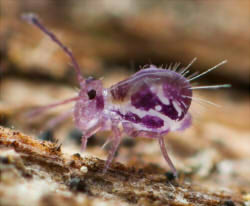
SPRINGTAIL:
not true insects, but another group of hexapodal arthropods! Springtails are extremely tiny, leaping omnivores and scavengers that come in many shapes. Many species also have a habit of walking around on water, forming floating mats together.
As a Pokemon: a lot of what I said about the flea would also apply here. Maybe they would be offensive and defensive counterparts, bug/dark and bug/fairy?
Photo by Andy Murray
not true insects, but another group of hexapodal arthropods! Springtails are extremely tiny, leaping omnivores and scavengers that come in many shapes. Many species also have a habit of walking around on water, forming floating mats together.
As a Pokemon: a lot of what I said about the flea would also apply here. Maybe they would be offensive and defensive counterparts, bug/dark and bug/fairy?
Photo by Andy Murray
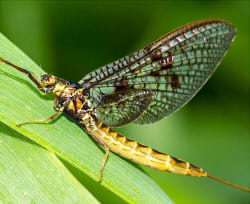
MAYFLY:
Mayflies are famous for how short-lived they are, emerging in massive numbers just to mate and die...though they actually spend many years prior as an aquatic larva!
As a Pokemon: I like that bug/ghost is thus far unique to Shedinja, but considering the Mayfly's reputation, I'd say this should go from bug/water to bug/flying, then surprisingly attempt evolution into a bug/ghost only one more level later. I imagine it'd have some pretty cool secret moves if you delay that a while, though.
Photo by Michael Palmer
Mayflies are famous for how short-lived they are, emerging in massive numbers just to mate and die...though they actually spend many years prior as an aquatic larva!
As a Pokemon: I like that bug/ghost is thus far unique to Shedinja, but considering the Mayfly's reputation, I'd say this should go from bug/water to bug/flying, then surprisingly attempt evolution into a bug/ghost only one more level later. I imagine it'd have some pretty cool secret moves if you delay that a while, though.
Photo by Michael Palmer
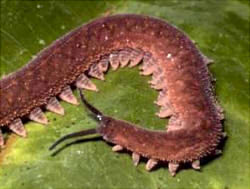
VELVET WORM:
Increasingly (and deservedly!) famous lately, these basal, soft bodied arthropods are the closest living relative to the ancient Anomalocaris (Anorith!) and may look innocent, but actually fire streams of poisonous glue from their heads to trap faster-moving prey at a distance.
As a Pokemon: my own concept for this one has always been a bug/ice type, spraying freezing compounds that work much like the real thing's glue attack. Interestingly enough, several species of velvet worm do live in icy environments!
Photo by Sonia Martinez
Increasingly (and deservedly!) famous lately, these basal, soft bodied arthropods are the closest living relative to the ancient Anomalocaris (Anorith!) and may look innocent, but actually fire streams of poisonous glue from their heads to trap faster-moving prey at a distance.
As a Pokemon: my own concept for this one has always been a bug/ice type, spraying freezing compounds that work much like the real thing's glue attack. Interestingly enough, several species of velvet worm do live in icy environments!
Photo by Sonia Martinez
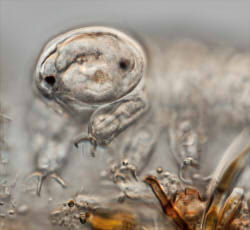
TARDIGRADE:
This one's really popular lately, as more and more people learn about their amazing survivability and just how darn cute they are. We aren't really sure what arthropod group they're closest to, but they're eight-legged, mostly microscopic, and can harden into a mummy-like state to survive long years of dry conditions.
As a Pokemon: my own region has a tardigrade that's naturally pure water type, but at 50% HP or less, it automatically falls asleep, becomes water/steel and maximizes its defenses, a Pokemon sort of designed around the use of "sleep talk."
Photo by Frank Fox
This one's really popular lately, as more and more people learn about their amazing survivability and just how darn cute they are. We aren't really sure what arthropod group they're closest to, but they're eight-legged, mostly microscopic, and can harden into a mummy-like state to survive long years of dry conditions.
As a Pokemon: my own region has a tardigrade that's naturally pure water type, but at 50% HP or less, it automatically falls asleep, becomes water/steel and maximizes its defenses, a Pokemon sort of designed around the use of "sleep talk."
Photo by Frank Fox

TERMITE:
people tend to think of termites as less interesting ants that happen to eat wood, but they're actually a super-social variety of cockroach with a lot of unique biology. Some species even have a soldier caste that fires adhesive slime from their gun-like heads!
As a Pokemon: I'm still disappointed that our only ant Pokemon is a single stage and single form. We need a social insect Pokemon with the full life cycle, worker caste, soldier caste and queen. Maybe these could also be cute little "lumberjacks" that build wooden structures, possibly even wearing wooden armor they've crafted.
people tend to think of termites as less interesting ants that happen to eat wood, but they're actually a super-social variety of cockroach with a lot of unique biology. Some species even have a soldier caste that fires adhesive slime from their gun-like heads!
As a Pokemon: I'm still disappointed that our only ant Pokemon is a single stage and single form. We need a social insect Pokemon with the full life cycle, worker caste, soldier caste and queen. Maybe these could also be cute little "lumberjacks" that build wooden structures, possibly even wearing wooden armor they've crafted.
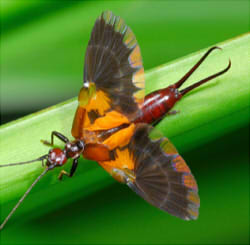
EARWIG:
extremely common just about everywhere, but shy enough that some people never even notice them. Earwigs are highly adaptable creatures who use their pincer-like tails for a variety of purposes, and even have beautiful, dove-like wings they can fold down tiny on their relatively small thorax.
As a Pokemon: another good one for bug/dark, I think, but perhaps with an alternate flying form that looks surprisingly angelic. Both would have a tail stylized like a big set of scissors or pruning shears.
Photo by Griffin Pest Control?
extremely common just about everywhere, but shy enough that some people never even notice them. Earwigs are highly adaptable creatures who use their pincer-like tails for a variety of purposes, and even have beautiful, dove-like wings they can fold down tiny on their relatively small thorax.
As a Pokemon: another good one for bug/dark, I think, but perhaps with an alternate flying form that looks surprisingly angelic. Both would have a tail stylized like a big set of scissors or pruning shears.
Photo by Griffin Pest Control?
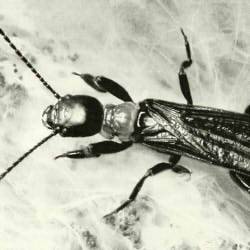
WEBSPINNER:
this highly obscure group of insects secrete silk from their fat little front legs, and use it to create community nests together in the cracks of tree bark!
As a Pokemon: maybe they don't look like much, but a webspinner Pokemon could be a clothing maker like Leavanny, producing actual woven fabric and almost human-like outfits in variable shapes and colors.
this highly obscure group of insects secrete silk from their fat little front legs, and use it to create community nests together in the cracks of tree bark!
As a Pokemon: maybe they don't look like much, but a webspinner Pokemon could be a clothing maker like Leavanny, producing actual woven fabric and almost human-like outfits in variable shapes and colors.
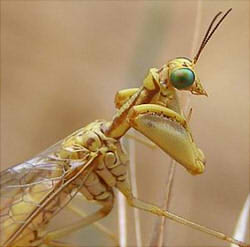
MANTIDFLY:
You would almost never guess this was related to antlions, rather than either mantises or wasps. Their front end has evolved very much like a mantid and hunts in a similar fashion, but the back half tends to imitate a stinging wasp to ward off larger predators. Most uniquely, their larvae are parasites of spider egg sacs.
As a Pokemon: I like Scyther, Scizor and Lurantis, but they still don't fully capture the personality of a mantis. Instead of trying that with yet another true Mantodean, they could just give one of these the most life-like "mantis" head and claws in the series, but the rest of the body might rather strikingly imitate a Beedrill, which the Pokemon could prey upon.
Photo by H. Dumas
You would almost never guess this was related to antlions, rather than either mantises or wasps. Their front end has evolved very much like a mantid and hunts in a similar fashion, but the back half tends to imitate a stinging wasp to ward off larger predators. Most uniquely, their larvae are parasites of spider egg sacs.
As a Pokemon: I like Scyther, Scizor and Lurantis, but they still don't fully capture the personality of a mantis. Instead of trying that with yet another true Mantodean, they could just give one of these the most life-like "mantis" head and claws in the series, but the rest of the body might rather strikingly imitate a Beedrill, which the Pokemon could prey upon.
Photo by H. Dumas
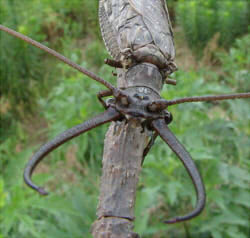
DOBSONFLY:
Beginning its life as a predatory, aquatic "Hellgrammite," the adult dobsonfly barely feeds at all. Females have short, powerful jaws that can deliver a painful defensive chomp, but the long and massive mandibles of the males are incapable of biting, used only to gently hold the female during mating.
As a Pokemon: this would be another perfectly logical purpose for gender-based forms. They could be tailored for use in double battles, but it would be the bigger, scarier looking male who uses support moves on the faster, more offensive female; a romantic Warrior and Healer couple.
Photo by Dehaan
Beginning its life as a predatory, aquatic "Hellgrammite," the adult dobsonfly barely feeds at all. Females have short, powerful jaws that can deliver a painful defensive chomp, but the long and massive mandibles of the males are incapable of biting, used only to gently hold the female during mating.
As a Pokemon: this would be another perfectly logical purpose for gender-based forms. They could be tailored for use in double battles, but it would be the bigger, scarier looking male who uses support moves on the faster, more offensive female; a romantic Warrior and Healer couple.
Photo by Dehaan
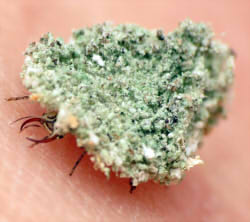
LACEWING:
These pretty flying predators are directly related to antlions with somewhat similar larvae, though Lacewing larvae are more active hunters and many species cover themselves in detritus for camouflage, resembling a ball of litter with legs. Another common name for the adults in some places is, apparently, "stink fly," because they don't smell so great up close.
As a Pokemon: the larval stage would be the really fun one, but maybe in the Pokemon world, the adult could keep the garbage armor; a beautiful flier ironically armoring itself with stinking filth.
Photo by Katja Schulz
These pretty flying predators are directly related to antlions with somewhat similar larvae, though Lacewing larvae are more active hunters and many species cover themselves in detritus for camouflage, resembling a ball of litter with legs. Another common name for the adults in some places is, apparently, "stink fly," because they don't smell so great up close.
As a Pokemon: the larval stage would be the really fun one, but maybe in the Pokemon world, the adult could keep the garbage armor; a beautiful flier ironically armoring itself with stinking filth.
Photo by Katja Schulz
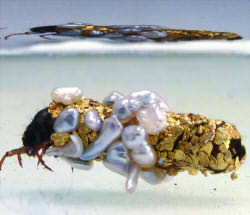
CADDISFLY:
the adult is a fairly plain, harmless flying insect, but larval caddisflies are sort of like aquatic bagworms, building a cocoon of tiny pebbles and sand grains they stick together with slime. One artist even experimented with giving them gold, pearls and tiny gems to work with!
As a Pokemon: this could work a lot like I described for the Lacewing or even a counterpart to it, with "treasure" armor at all stages. In my own region concept, that's actually what I finally settled on for my own bug/dragon entry.
Photo by Hubert Duprat
the adult is a fairly plain, harmless flying insect, but larval caddisflies are sort of like aquatic bagworms, building a cocoon of tiny pebbles and sand grains they stick together with slime. One artist even experimented with giving them gold, pearls and tiny gems to work with!
As a Pokemon: this could work a lot like I described for the Lacewing or even a counterpart to it, with "treasure" armor at all stages. In my own region concept, that's actually what I finally settled on for my own bug/dragon entry.
Photo by Hubert Duprat
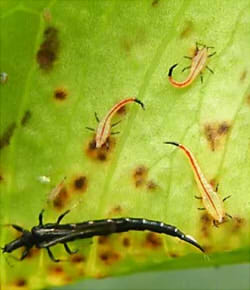
THRIPS:
You may have never heard of Thrips if you're not into gardening. These tiny plant pests are slender and flexible, sometimes have crab-like claws for forelegs and can even bite rather painfully for their small size. Interestingly, those that fly do so by "clapping" their feather-like wings together, a mechanism of sustained flight exhibited in only a couple of other creatures.
As a Pokemon: In reading up more about thrips, I found more than one story of them accidentally entering and shorting out electronics, which made me wonder why there's no "computer glitch" Pokemon. I could see one of these strange, long-tailed insects as an angular, brightly glowing bug/electric type!
Photo by docj96
You may have never heard of Thrips if you're not into gardening. These tiny plant pests are slender and flexible, sometimes have crab-like claws for forelegs and can even bite rather painfully for their small size. Interestingly, those that fly do so by "clapping" their feather-like wings together, a mechanism of sustained flight exhibited in only a couple of other creatures.
As a Pokemon: In reading up more about thrips, I found more than one story of them accidentally entering and shorting out electronics, which made me wonder why there's no "computer glitch" Pokemon. I could see one of these strange, long-tailed insects as an angular, brightly glowing bug/electric type!
Photo by docj96
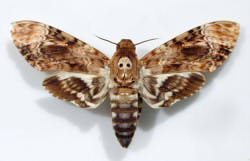
DEATH'S HEAD MOTH:
Yes, we have a million moth Pokemon, but few of them borrow from any specific moth of any memorable note. The Death's Head however is pretty famous gothic imagery for the skull-like marking on its back. It also has large, biting caterpillars that sometimes feed on nightshade, the adults can "scream" in defense and they routinely steal honey from bee's nests!
As a Pokemon: I mentioned in the Orbeetle review that I could see one of these as bug/psychic with a witch or wizard-like motif. The skull could also be upgraded from a mere marking on its back to an actual Duskull-like face.
Photo by Eric G Gagnon
Yes, we have a million moth Pokemon, but few of them borrow from any specific moth of any memorable note. The Death's Head however is pretty famous gothic imagery for the skull-like marking on its back. It also has large, biting caterpillars that sometimes feed on nightshade, the adults can "scream" in defense and they routinely steal honey from bee's nests!
As a Pokemon: I mentioned in the Orbeetle review that I could see one of these as bug/psychic with a witch or wizard-like motif. The skull could also be upgraded from a mere marking on its back to an actual Duskull-like face.
Photo by Eric G Gagnon
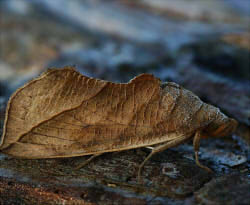
VAMPIRE MOTH:
It looks remarkably like an old, rotten leaf when its wings are closed, but this is not only a moth, it's a moth with an even darker streak than the death's head; the only moth in the world that feeds by penetrating the skin of large animals and sucking blood!
As a Pokemon: maybe they'd just want to combine this one with the death's head, for a vampiric dark or ghost type moth?
Photo by Ilia Ustyantsev
It looks remarkably like an old, rotten leaf when its wings are closed, but this is not only a moth, it's a moth with an even darker streak than the death's head; the only moth in the world that feeds by penetrating the skin of large animals and sucking blood!
As a Pokemon: maybe they'd just want to combine this one with the death's head, for a vampiric dark or ghost type moth?
Photo by Ilia Ustyantsev
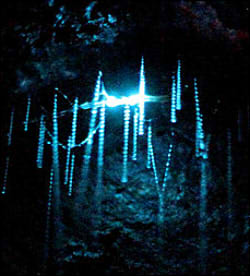
GLOW WORM:
Several insect larvae produce light and go by the name "glow worm," but one of the most interesting are those belonging to certain fungus gnats. Hanging from cave ceilings, their illuminated slime imitates twinkling starlight, fooling lost insects into getting trapped!
As a Pokemon: a good one for another bug/electric. Maybe it could be so long that it stands like a street lamp.
Several insect larvae produce light and go by the name "glow worm," but one of the most interesting are those belonging to certain fungus gnats. Hanging from cave ceilings, their illuminated slime imitates twinkling starlight, fooling lost insects into getting trapped!
As a Pokemon: a good one for another bug/electric. Maybe it could be so long that it stands like a street lamp.
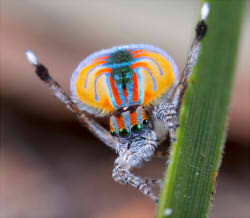
PEACOCK SPIDER:
one of the most beloved of the jumping spiders, in turn the most beloved spiders! These are named for the fantastically gorgeous, flaring abdominal flaps of the males, who use them as part of an elaborate courtship dance.
As a Pokemon: Joltik was a pretty big hit, so I think we could use a spider Pokemon that actually remains tiny and fluffy. A jumping spider would certainly make for an unexpected bug/fairy Pokemon.
Photo by Jurgen Otto
one of the most beloved of the jumping spiders, in turn the most beloved spiders! These are named for the fantastically gorgeous, flaring abdominal flaps of the males, who use them as part of an elaborate courtship dance.
As a Pokemon: Joltik was a pretty big hit, so I think we could use a spider Pokemon that actually remains tiny and fluffy. A jumping spider would certainly make for an unexpected bug/fairy Pokemon.
Photo by Jurgen Otto
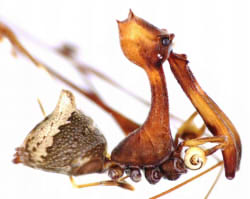
PELICAN SPIDER:
These spiders feed almost exclusively on other spiders, using their long "necks" and tong-like fangs to bite their prey at a safer distance. We're kind of about to run through a few things I featured in Spiderween.
As a Pokemon: it really does look bird-like. What if they toyed with that a little, put a membrane between its legs and made it a *flying* spider?
Photo by Hannah Wood
These spiders feed almost exclusively on other spiders, using their long "necks" and tong-like fangs to bite their prey at a safer distance. We're kind of about to run through a few things I featured in Spiderween.
As a Pokemon: it really does look bird-like. What if they toyed with that a little, put a membrane between its legs and made it a *flying* spider?
Photo by Hannah Wood
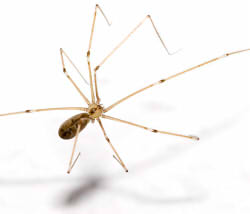
CELLAR SPIDER:
Extremely thin, long limbed and transparent, these common household spiders were originally inhabitants of caves!
As a Pokemon: another I think could be bug/fairy, I immediately imagine the spider itself integrated with its own transparent cobweb.
Extremely thin, long limbed and transparent, these common household spiders were originally inhabitants of caves!
As a Pokemon: another I think could be bug/fairy, I immediately imagine the spider itself integrated with its own transparent cobweb.
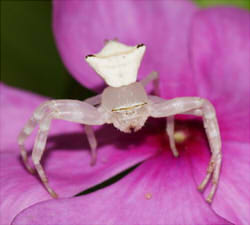
CRAB SPIDER:
These spiders were once thought to simply wait around on flowers for insects to drop by, but we now know they reflect UV light in a similar fashion to flowers themselves, actively luring prey with or without a flower to perch on! This same discovery was made about flower-mimicking mantids not too long ago.
As a Pokemon: Lurantis and the fact that it really is just a plant is already the coolest thing they could have done with something like this, but a flower-mimic bug type would still be neat, and something different they could do is have it actually look like a harmless grass-type in the same region.
Photo by Vengolis
These spiders were once thought to simply wait around on flowers for insects to drop by, but we now know they reflect UV light in a similar fashion to flowers themselves, actively luring prey with or without a flower to perch on! This same discovery was made about flower-mimicking mantids not too long ago.
As a Pokemon: Lurantis and the fact that it really is just a plant is already the coolest thing they could have done with something like this, but a flower-mimic bug type would still be neat, and something different they could do is have it actually look like a harmless grass-type in the same region.
Photo by Vengolis
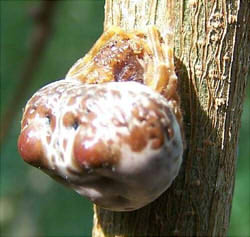
BOLAS SPIDER:
The female bolas spider doesn't spin a web, but produces a ball of glue on the end of a single strand. Her body mimics bird droppings or a hunk of wood, and the "fishing line" smells like a female moth to attract male moth prey!
As a Pokemon: this suggestion is kind of out of left field, but what if the goo-trap floated up instead of hanging down, like a balloon? The spider could hang from it, and maybe have an almost clown-like motif.
Photo by Dutch
The female bolas spider doesn't spin a web, but produces a ball of glue on the end of a single strand. Her body mimics bird droppings or a hunk of wood, and the "fishing line" smells like a female moth to attract male moth prey!
As a Pokemon: this suggestion is kind of out of left field, but what if the goo-trap floated up instead of hanging down, like a balloon? The spider could hang from it, and maybe have an almost clown-like motif.
Photo by Dutch
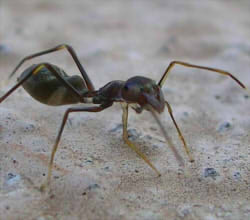
ANT MIMIC SPIDER:
MANY spiders imitate ants in various ways, not usually to eat ants, but actually because the kinds of things that eat spiders are much more afraid of an ant colony than an arachnid!
As a Pokemon: a spider that pretends to be a Durant would be fun, though I'd still rather a new ant Pokemon with multiple castes and a nest big enough to explore as a dungeon, where this would fit right in as something more secret to catch. It could evolve to look a little more like a spider, but maybe with a false ant incorporated as a smaller "lure."
Photo by Shyamal
MANY spiders imitate ants in various ways, not usually to eat ants, but actually because the kinds of things that eat spiders are much more afraid of an ant colony than an arachnid!
As a Pokemon: a spider that pretends to be a Durant would be fun, though I'd still rather a new ant Pokemon with multiple castes and a nest big enough to explore as a dungeon, where this would fit right in as something more secret to catch. It could evolve to look a little more like a spider, but maybe with a false ant incorporated as a smaller "lure."
Photo by Shyamal
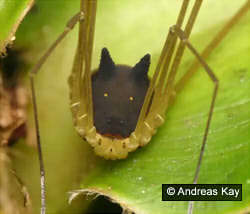
HARVESTMAN:
Such a common, well known group of arachnids, but appearing in virtually no media at all. Harvestman aren't spiders, but nonvenomous omnivores known for their incredibly long, thin legs, which they can even discard to escape the grasp of predators.
As a Pokemon: this harvestman with a body like a cartoon dog face has been showing up in a lot of articles. Gamefreak can't resist it forever! I think any typing might work.
Photo by Andreas Kay
Such a common, well known group of arachnids, but appearing in virtually no media at all. Harvestman aren't spiders, but nonvenomous omnivores known for their incredibly long, thin legs, which they can even discard to escape the grasp of predators.
As a Pokemon: this harvestman with a body like a cartoon dog face has been showing up in a lot of articles. Gamefreak can't resist it forever! I think any typing might work.
Photo by Andreas Kay
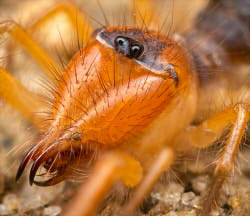
SOLIFUGID:
Going by such common names as "wind scorpion," "sun spider" and more recently "camel spider," these furry desert dwellers have enormous, powerful crushing jaws and elongated, sticky pedipalps they use to chase down and devour prey at high speed!
As a Pokemon: I think this is one that would speak for itself, really; no need for a surprise twist, theme or elemental gimmick. Just a big ol' giant camel spider!
Photo by Thomas Shahan
Going by such common names as "wind scorpion," "sun spider" and more recently "camel spider," these furry desert dwellers have enormous, powerful crushing jaws and elongated, sticky pedipalps they use to chase down and devour prey at high speed!
As a Pokemon: I think this is one that would speak for itself, really; no need for a surprise twist, theme or elemental gimmick. Just a big ol' giant camel spider!
Photo by Thomas Shahan
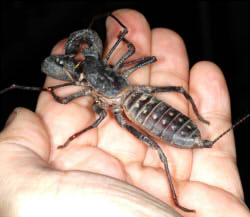
VINEGAROON:
This arachnid has thick, pulverizing claws it also uses for digging, long whip-like forelegs it employs as antennae, and the ability to spray acetic acid as a defense, the same thing giving vinegar its sharp smell and flavor.
As a Pokemon: my own concept for one of these was a bug/fire type; the "whips" could resemble lit matchsticks, and the abdomen a red tank of gasoline.
Photo by Acrocynus
This arachnid has thick, pulverizing claws it also uses for digging, long whip-like forelegs it employs as antennae, and the ability to spray acetic acid as a defense, the same thing giving vinegar its sharp smell and flavor.
As a Pokemon: my own concept for one of these was a bug/fire type; the "whips" could resemble lit matchsticks, and the abdomen a red tank of gasoline.
Photo by Acrocynus
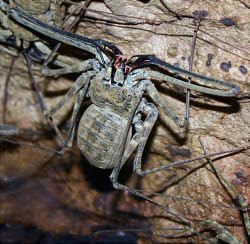
WHIPSPIDER:
Another arachnid with sensitive whip-legs, these creatures evolved their especially long limbs and flattened shape so they could spend much of their sitting motionless on the walls of caves or hollow trees, gently waving their whips to not only detect prey, but guide it into their spiny palps!
As a Pokemon: not to be a broken record but where ARE all the bug/dark combos in Pokemon? The fact that this animal functions like a living bear trap is kind of perfect for the typing already.
Photo by Greg Hume
Another arachnid with sensitive whip-legs, these creatures evolved their especially long limbs and flattened shape so they could spend much of their sitting motionless on the walls of caves or hollow trees, gently waving their whips to not only detect prey, but guide it into their spiny palps!
As a Pokemon: not to be a broken record but where ARE all the bug/dark combos in Pokemon? The fact that this animal functions like a living bear trap is kind of perfect for the typing already.
Photo by Greg Hume
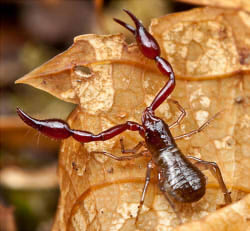
PSEUDOSCORPION:
Some of the smallest predatory arachnids, these actually produce venom from their pincers to hunt springtails and mites! They were also once called "Book Scorpions," because it was common to find them between the pages of old books where they preyed upon book lice.
As a Pokemon: I like the book part. Make it nerdy, like Blipbug! It could have a growth like a scholarly hat!
Photo by Marshal Hedin
Some of the smallest predatory arachnids, these actually produce venom from their pincers to hunt springtails and mites! They were also once called "Book Scorpions," because it was common to find them between the pages of old books where they preyed upon book lice.
As a Pokemon: I like the book part. Make it nerdy, like Blipbug! It could have a growth like a scholarly hat!
Photo by Marshal Hedin

TICK:
One of my favorite animals, but another of the world's most reviled. Ticks are actually very large blood-sucking mites, and I've written a whole article about them here!
As a Pokemon: I talked about my idea for a psychic "brain tick" in my Orbeetle review, but to borrow a little from the Bat Fly a ways back, what if a tick Pokemon existed in symbiosis with a canine? The tick could be big enough to serve as a helmet or a whole turtle-like shell, like Parasect's mushroom.
One of my favorite animals, but another of the world's most reviled. Ticks are actually very large blood-sucking mites, and I've written a whole article about them here!
As a Pokemon: I talked about my idea for a psychic "brain tick" in my Orbeetle review, but to borrow a little from the Bat Fly a ways back, what if a tick Pokemon existed in symbiosis with a canine? The tick could be big enough to serve as a helmet or a whole turtle-like shell, like Parasect's mushroom.
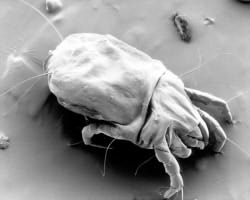
DUST MITE:
Speaking of mites, these are perhaps the most famous only because they trigger so many allergies and worsen asthma. The interesting reason? Their digestive enzymes are so powerful, they remain corrosive in the mite's microscopic flecks of feces, not a fun thing to get in your sensitive respiratory membranes.
As a Pokemon: Trubbish and Garbodor are already "dust bunny" themed, but I'd still love to see a dust mite Pokemon actually covered in dust, and maybe holding two of its legs up like little ears.
Speaking of mites, these are perhaps the most famous only because they trigger so many allergies and worsen asthma. The interesting reason? Their digestive enzymes are so powerful, they remain corrosive in the mite's microscopic flecks of feces, not a fun thing to get in your sensitive respiratory membranes.
As a Pokemon: Trubbish and Garbodor are already "dust bunny" themed, but I'd still love to see a dust mite Pokemon actually covered in dust, and maybe holding two of its legs up like little ears.
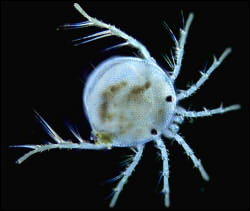
WATER MITE:
There are so many, many, many other species of mite, but we'll do just one more: many mites live underwater, and use their fuzzy legs to paddle and swim around. Some are predators, some are algae-eaters, and some of course are parasites on larger aquatic creatures.
As a Pokemon: maybe this crosses over too much with Dewpider, but how cute would it be to have a mite contained entirely inside a water bubble? It could roll it around from within like a hamster ball!
There are so many, many, many other species of mite, but we'll do just one more: many mites live underwater, and use their fuzzy legs to paddle and swim around. Some are predators, some are algae-eaters, and some of course are parasites on larger aquatic creatures.
As a Pokemon: maybe this crosses over too much with Dewpider, but how cute would it be to have a mite contained entirely inside a water bubble? It could roll it around from within like a hamster ball!
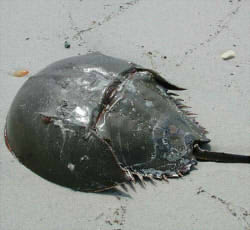
HORSESHOE CRAB:
Many feel Kabuto counts as one of these, but it really doesn't resemble one at all. We now know that these amazing marine scavengers are actually arachnids!
As a Pokemon: horseshoe crabs always reminded me of military helmets. You could give one a camouflage pattern, stern eyes peeking from under its shell, attached badge-like starfish and some battle scars.
Many feel Kabuto counts as one of these, but it really doesn't resemble one at all. We now know that these amazing marine scavengers are actually arachnids!
As a Pokemon: horseshoe crabs always reminded me of military helmets. You could give one a camouflage pattern, stern eyes peeking from under its shell, attached badge-like starfish and some battle scars.
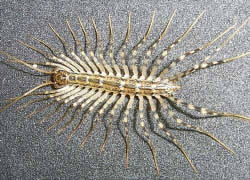
HOUSE CENTIPEDE:
Widely considered terrifying, but beneficial in homes as a predator of roaches and silverfish. House centipedes were once cave animals, which is why these extremely speedy hunters are so at home in basements and crawlspaces. The short body and absurdly long legs of these creatures give them a distinctly unique look from the kind of centipede that inspired either Scolipede or Centiskorch.
As a Pokemon: the image that popped into my head has a still chunkier body than the real thing, with a color pattern that evokes a laced-up sneaker.
Widely considered terrifying, but beneficial in homes as a predator of roaches and silverfish. House centipedes were once cave animals, which is why these extremely speedy hunters are so at home in basements and crawlspaces. The short body and absurdly long legs of these creatures give them a distinctly unique look from the kind of centipede that inspired either Scolipede or Centiskorch.
As a Pokemon: the image that popped into my head has a still chunkier body than the real thing, with a color pattern that evokes a laced-up sneaker.
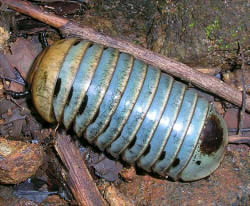
MILLIPEDE:
What we're seeing here is specifically a pill millipede, not to be confused with the "pillbugs" that are actually isopods. In stark contrast to centipedes, millipedes are thick, heavy, slow moving herbivores, and while centipedes are venomous, millipedes are highly poisonous. This means that they don't bite you, but you don't want to bite them either.
As a Pokemon: we didn't get the steam train people expected from Rolycoly, but a millipede could resemble one easy. Maybe it could also have an evolution, branched evolution or alternate form into a faster, more modern but frailer bullet train.
What we're seeing here is specifically a pill millipede, not to be confused with the "pillbugs" that are actually isopods. In stark contrast to centipedes, millipedes are thick, heavy, slow moving herbivores, and while centipedes are venomous, millipedes are highly poisonous. This means that they don't bite you, but you don't want to bite them either.
As a Pokemon: we didn't get the steam train people expected from Rolycoly, but a millipede could resemble one easy. Maybe it could also have an evolution, branched evolution or alternate form into a faster, more modern but frailer bullet train.
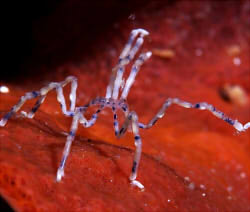
SEA SPIDER:
Not a spider at all, but a member of its own bizarre arthropod group, a spider is truly more leg than almost any other animal, its legs even housing parts of its digestive tract! It feeds on fluids from corals, sponges and other slow or stationary invertebrates.
As a Pokemon: this is another one that doesn't need any elaboration, just a bundle of colorful, absurdly long legs. Maybe have its long, thin head project directly down from the center like an "oil drill."
Photo by Richard Zerpe
Not a spider at all, but a member of its own bizarre arthropod group, a spider is truly more leg than almost any other animal, its legs even housing parts of its digestive tract! It feeds on fluids from corals, sponges and other slow or stationary invertebrates.
As a Pokemon: this is another one that doesn't need any elaboration, just a bundle of colorful, absurdly long legs. Maybe have its long, thin head project directly down from the center like an "oil drill."
Photo by Richard Zerpe
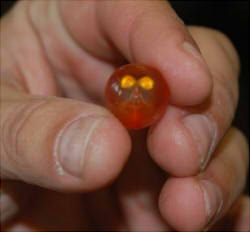
OSTRACOD:
Ostracods or "seed shrimp" are our first Crustacean in the list, so named because all their shrimpy anatomy is protected by a transparent, clam-like shell! Most species are the size of pinheads, but Gigantocypris in the deep sea abyss reaches the size of a grape, with concave golden mirrors for eyes to see in near-total darkness.
As a Pokemon: make it look like a diving helmet! Just a diving helmet with two instead of the usual single porthole!
Ostracods or "seed shrimp" are our first Crustacean in the list, so named because all their shrimpy anatomy is protected by a transparent, clam-like shell! Most species are the size of pinheads, but Gigantocypris in the deep sea abyss reaches the size of a grape, with concave golden mirrors for eyes to see in near-total darkness.
As a Pokemon: make it look like a diving helmet! Just a diving helmet with two instead of the usual single porthole!
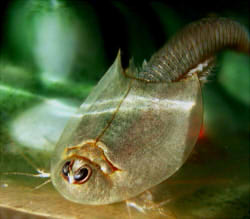
TRIOPS:
Also known as "tadpole shrimp," several species of these "three eyed" omnivores can survive for years as eggs, waiting for rare rainfall before they hatch and live a fast-paced life in temporary ponds.
As a Pokemon: It'd be a lot of fun if there were "vernal pool" Pokemon, that you could resuscitate from unusual Pokemon eggs you dig up in deserts. I like the idea of it being pure ground with "water absorb."
Photo by Jurvetson
Also known as "tadpole shrimp," several species of these "three eyed" omnivores can survive for years as eggs, waiting for rare rainfall before they hatch and live a fast-paced life in temporary ponds.
As a Pokemon: It'd be a lot of fun if there were "vernal pool" Pokemon, that you could resuscitate from unusual Pokemon eggs you dig up in deserts. I like the idea of it being pure ground with "water absorb."
Photo by Jurvetson
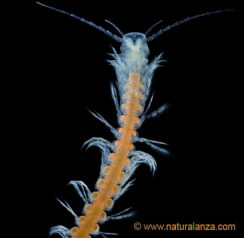
REMIPEDE:
These especially strange crustaceans have long bodies with many, many pairs of legs, like a centipede or millipede. Totally blind, they inhabit only caves in saltwater environments, and are also one of the only Crustaceans that possess a venomous bite!
As a Pokemon: another good one for for blind cave-creature category, and I can imagine a long, pale remipede actually being one of the prettier Pokemon, like an arthropod Milotic.
Photo by Ulrike Strecker
These especially strange crustaceans have long bodies with many, many pairs of legs, like a centipede or millipede. Totally blind, they inhabit only caves in saltwater environments, and are also one of the only Crustaceans that possess a venomous bite!
As a Pokemon: another good one for for blind cave-creature category, and I can imagine a long, pale remipede actually being one of the prettier Pokemon, like an arthropod Milotic.
Photo by Ulrike Strecker
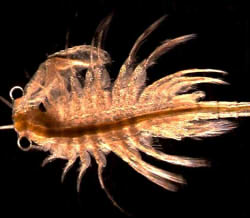
FAIRY SHRIMP:
You may also know these as "fairy shrimp" or "sea monkeys," and they're another crustacean often adapted to aquatic ecosystems that may only last for weeks at a time or less, even in salty and sandy desert environments.
As a Pokemon: Just from the way they look, I want to think they'd be suitable for a water/fire Pokemon that lives in boiling hot springs, or a pure fire type hatched by contact with lava rather than rain.
Photo by Djpmapleferryman
You may also know these as "fairy shrimp" or "sea monkeys," and they're another crustacean often adapted to aquatic ecosystems that may only last for weeks at a time or less, even in salty and sandy desert environments.
As a Pokemon: Just from the way they look, I want to think they'd be suitable for a water/fire Pokemon that lives in boiling hot springs, or a pure fire type hatched by contact with lava rather than rain.
Photo by Djpmapleferryman
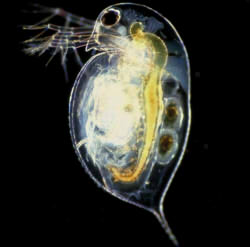
DAPHNIA:
Also called "water fleas," Daphnia are crystal-clear freshwater creatures with a single large eye and a pair of large, branching forelimbs. They're commonly studied in biology classes, especially in Japan, where they're famous for their small size and rapid reproduction.
As a Pokemon: if they ever repeat the gimmick of Wishiwashi, this would be the most appropriate place for it, but I could also imagine it as an electric type modeled like a lightbulb.
Photo by Paul Herbert
Also called "water fleas," Daphnia are crystal-clear freshwater creatures with a single large eye and a pair of large, branching forelimbs. They're commonly studied in biology classes, especially in Japan, where they're famous for their small size and rapid reproduction.
As a Pokemon: if they ever repeat the gimmick of Wishiwashi, this would be the most appropriate place for it, but I could also imagine it as an electric type modeled like a lightbulb.
Photo by Paul Herbert
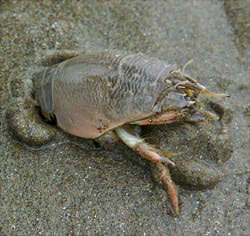
MOLE CRAB:
Actually more related to lobsters and hermit crabs, these creatures spend their life tunneling backwards in wet beach sand. When a wave hits, they unfurl their long, feathery antennae to quickly collect phytoplankton from the water.
As a Pokemon: why is Diglett the only ground type we've ever seen that's partially buried? I want more of those! A mole crab that's mostly eye stalks and colorful fluffy feelers would be delightful!
Photo by Jkirkhart35
Actually more related to lobsters and hermit crabs, these creatures spend their life tunneling backwards in wet beach sand. When a wave hits, they unfurl their long, feathery antennae to quickly collect phytoplankton from the water.
As a Pokemon: why is Diglett the only ground type we've ever seen that's partially buried? I want more of those! A mole crab that's mostly eye stalks and colorful fluffy feelers would be delightful!
Photo by Jkirkhart35
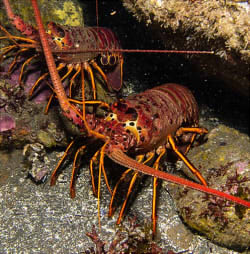
SPINY LOBSTER:
We have crabs and a crawfish, but NO lobster? I guess a regular lobster would still feel like a Crawdaunt repeat, but maybe a spiny lobster? They're basically just incredibly gigantic shrimp.
As a Pokemon: one idea I had for a lobster was a crusty old fisherman with a spiny "beard" and hook-tipped antennae, bent like a couple of fishing poles. Since it already lives underwater, what it fishes in are underwater brine pools.
Photo by Ed Bierman
We have crabs and a crawfish, but NO lobster? I guess a regular lobster would still feel like a Crawdaunt repeat, but maybe a spiny lobster? They're basically just incredibly gigantic shrimp.
As a Pokemon: one idea I had for a lobster was a crusty old fisherman with a spiny "beard" and hook-tipped antennae, bent like a couple of fishing poles. Since it already lives underwater, what it fishes in are underwater brine pools.
Photo by Ed Bierman
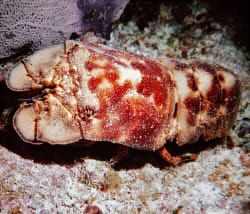
SLIPPER LOBSTER:
An especially strange looking "lobster," the large flat plates on its front are actually a pair of its antennae, and are used to dig around in sand or mud for their food.
As a Pokemon: maybe a steel type, and I feel like those antennae are begging to be stylized into a pair of rotating saws. Did you know some sea creatures eat sunken wood, including some crustaceans? Maybe this Pokemon chews up old shipwrecks the way isopods devour a whale carcass.
Photo by Betty Wills
An especially strange looking "lobster," the large flat plates on its front are actually a pair of its antennae, and are used to dig around in sand or mud for their food.
As a Pokemon: maybe a steel type, and I feel like those antennae are begging to be stylized into a pair of rotating saws. Did you know some sea creatures eat sunken wood, including some crustaceans? Maybe this Pokemon chews up old shipwrecks the way isopods devour a whale carcass.
Photo by Betty Wills
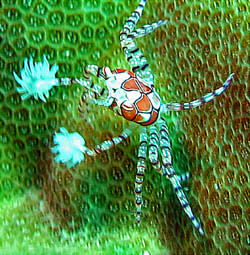
BOXER CRAB:
This adorable little reef crab isn't content to defend itself with only its claws; it prefers to carry a pair of living, stinging anemones around to shove in the face of attackers.
As a Pokemon: it already is one! I guess it could be poison/fighting or electric/fighting, and I'd love if the anemones were a pokemon of their own in a similar fashion to Cramorant and Arrokuda.
Photo by Hectonichus
This adorable little reef crab isn't content to defend itself with only its claws; it prefers to carry a pair of living, stinging anemones around to shove in the face of attackers.
As a Pokemon: it already is one! I guess it could be poison/fighting or electric/fighting, and I'd love if the anemones were a pokemon of their own in a similar fashion to Cramorant and Arrokuda.
Photo by Hectonichus
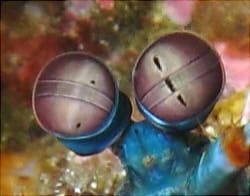
STOMATOPOD:
You should all know the mantis shrimp! Famous for their incredible eyesight and the fact that some species are "spearers," but others are "smashers," their claws in both cases striking with unbelievable force.
As a Pokemon: another shoe-in for a fighting crustacean, and it could have both the spearing claw and smashing claw, using them alternately.
Photo by Alexander Vasenin
You should all know the mantis shrimp! Famous for their incredible eyesight and the fact that some species are "spearers," but others are "smashers," their claws in both cases striking with unbelievable force.
As a Pokemon: another shoe-in for a fighting crustacean, and it could have both the spearing claw and smashing claw, using them alternately.
Photo by Alexander Vasenin
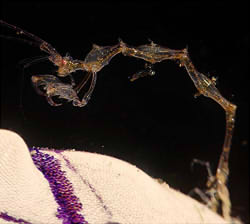
SKELETON SHRIMP:
Tiny, transparent predators with venomous claws, skeleton shrimp live very much like marine praying mantises, clinging to surfaces so they can hook passing prey.
As a Pokemon: we don't have any Pokemon that look like full blown skeletons, and thanks to Chinese media laws we probably never will, but one of these could come perhaps the closest. Not to bring up a fisherman theme again, but this one could look and function like one big living fishing pole, too.
Photo by Rickard Zerpe
Tiny, transparent predators with venomous claws, skeleton shrimp live very much like marine praying mantises, clinging to surfaces so they can hook passing prey.
As a Pokemon: we don't have any Pokemon that look like full blown skeletons, and thanks to Chinese media laws we probably never will, but one of these could come perhaps the closest. Not to bring up a fisherman theme again, but this one could look and function like one big living fishing pole, too.
Photo by Rickard Zerpe
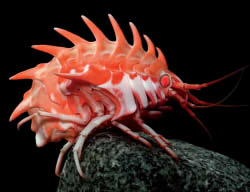
DEEP SEA AMPHIPOD:
Everyone's always so impressed by the giant abyssal isopods, but how about this spiny, colorful amphipod, a crustacean whose cousins are usually no bigger than fleas? Several species exist with various colors, shapes and spininess, some even associated with such extreme environments as freezing arctic water or boiling hydrothermal vents.
As a Pokemon: there's potential already there for combinations of bug, water, ice or fire. Design-wise, the whole creature could be stylized like a jagged blade or even like the bones of a fish.
Everyone's always so impressed by the giant abyssal isopods, but how about this spiny, colorful amphipod, a crustacean whose cousins are usually no bigger than fleas? Several species exist with various colors, shapes and spininess, some even associated with such extreme environments as freezing arctic water or boiling hydrothermal vents.
As a Pokemon: there's potential already there for combinations of bug, water, ice or fire. Design-wise, the whole creature could be stylized like a jagged blade or even like the bones of a fish.
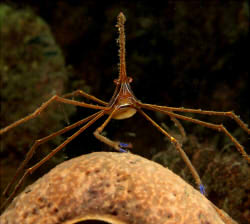
ARROW CRAB:
Maybe the thinnest and spindliest of all crabs, arrow crabs are reef-dwelling predators who use their thin arms to reach into crevices and pull out the marine worms on which they primarily feed.
As a Pokemon: I feel like this crab would look good in predominantly pink colors, and maybe even with a heart motif, kind of a "cupid's arrow" crab.
Photo by Nick Hobgood
Maybe the thinnest and spindliest of all crabs, arrow crabs are reef-dwelling predators who use their thin arms to reach into crevices and pull out the marine worms on which they primarily feed.
As a Pokemon: I feel like this crab would look good in predominantly pink colors, and maybe even with a heart motif, kind of a "cupid's arrow" crab.
Photo by Nick Hobgood
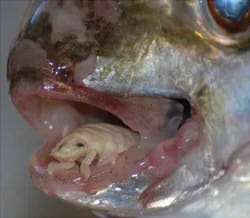
TONGUE BITER:
Another one all of you should know! The famous parasitic isopod that replaces the tongue of a host fish, and can even still be used by the host to manipulate food.
As a Pokemon: there's already a fan game with a tongue biter that evolves to basically wear its fish as a second skin, and I've also seen a couple of tongue biter designs out there with a humanoid shape and an attached fish as a "mermaid tail." I genuinely can't do better than either of those, to be honest.
Another one all of you should know! The famous parasitic isopod that replaces the tongue of a host fish, and can even still be used by the host to manipulate food.
As a Pokemon: there's already a fan game with a tongue biter that evolves to basically wear its fish as a second skin, and I've also seen a couple of tongue biter designs out there with a humanoid shape and an attached fish as a "mermaid tail." I genuinely can't do better than either of those, to be honest.
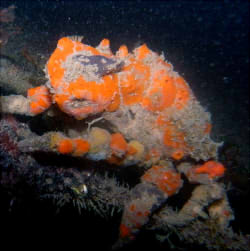
SPONGE CRAB:
There are several crabs that decorate themselves with natural camouflage, and a few of these specialize in using live sea sponge, which will subsequently grow to cover their body.
As a Pokemon: first we would need a sponge based Pokemon, obviously, then cover a crab Pokemon in it. If the sponges have their own eyes, the crab's claws stylistically become additional "heads!"
Photo by Sylke Rohrlach
There are several crabs that decorate themselves with natural camouflage, and a few of these specialize in using live sea sponge, which will subsequently grow to cover their body.
As a Pokemon: first we would need a sponge based Pokemon, obviously, then cover a crab Pokemon in it. If the sponges have their own eyes, the crab's claws stylistically become additional "heads!"
Photo by Sylke Rohrlach
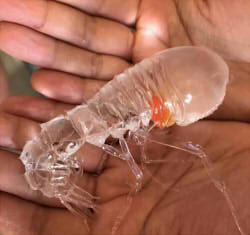
CYSTISOMA:
This is technically another kind of deep sea Amphipod, but with highly unusual anatomy. Its bulbous head is dominated by enormous eyes, but you can hardly tell, because the whole thing - eyes and all - is almost perfectly transparent, with microscopic structures that cancel out 99.9% of light reflection, rendering it quite invisible in dark water.
As a Pokemon: I'd love to see an "invisible" Pokemon for once, only temporarily fading into view for certain attacks, which might lend itself to a hologram-themed deep sea electric type.
This is technically another kind of deep sea Amphipod, but with highly unusual anatomy. Its bulbous head is dominated by enormous eyes, but you can hardly tell, because the whole thing - eyes and all - is almost perfectly transparent, with microscopic structures that cancel out 99.9% of light reflection, rendering it quite invisible in dark water.
As a Pokemon: I'd love to see an "invisible" Pokemon for once, only temporarily fading into view for certain attacks, which might lend itself to a hologram-themed deep sea electric type.
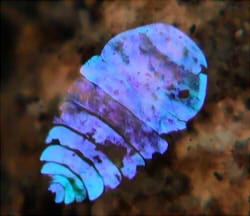
SEA SAPPHIRE:
This tiny crustacean is another than can render itself invisible, but when it's not invisible, its exoskeleton reflects light as a dazzling, intense blue shine.
As a Pokemon: you know how Kabutops takes basically a trilobite and uses it as the head and back of a more humanoid monster? I think that would work here too, but as a cute little fairy type. A more arthropodal Manaphy sort of Pokemon.
This tiny crustacean is another than can render itself invisible, but when it's not invisible, its exoskeleton reflects light as a dazzling, intense blue shine.
As a Pokemon: you know how Kabutops takes basically a trilobite and uses it as the head and back of a more humanoid monster? I think that would work here too, but as a cute little fairy type. A more arthropodal Manaphy sort of Pokemon.
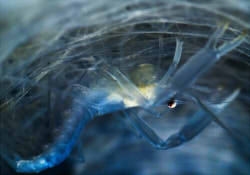
GLASS SPONGE SHRIMP:
Another symbiosis between sponges and crustaceans is the highly romantic story of one deep sea shrimp that raises its young within a basket-like glass sponge. A male and female will enter the sponge when they're small, but eventually grow too large to ever leave, spending the rest of their lives together inside of another animal.
As a Pokemon: a pair of mated shrimp inside a transparent, vase-like glass sponge would be adorable. Give the sponge its own personality and limbs while you're at it - no weirder than all the plants, fungi and objects with legs anyway.
Another symbiosis between sponges and crustaceans is the highly romantic story of one deep sea shrimp that raises its young within a basket-like glass sponge. A male and female will enter the sponge when they're small, but eventually grow too large to ever leave, spending the rest of their lives together inside of another animal.
As a Pokemon: a pair of mated shrimp inside a transparent, vase-like glass sponge would be adorable. Give the sponge its own personality and limbs while you're at it - no weirder than all the plants, fungi and objects with legs anyway.
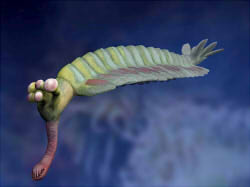
OPABINIA:
This mysterious prehistoric organism was similar in many ways to the Anomalocarids, but possessed five bulbous eyes and a strange gripping appendage on the end of a long, flexible trunk.
As a Pokemon: they never do invertebrate fossil types anymore, do they? Previously, both Kabuto and Anorith evolved into upright land creatures, so maybe Opabinia would go the same route, or more like a four-legged lizardy beast with that weird, weird head.
Art by Nobu Tamura
This mysterious prehistoric organism was similar in many ways to the Anomalocarids, but possessed five bulbous eyes and a strange gripping appendage on the end of a long, flexible trunk.
As a Pokemon: they never do invertebrate fossil types anymore, do they? Previously, both Kabuto and Anorith evolved into upright land creatures, so maybe Opabinia would go the same route, or more like a four-legged lizardy beast with that weird, weird head.
Art by Nobu Tamura
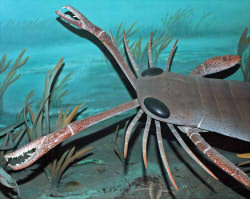
EURYPTERID:
Another prehistoric sea-bug, these scorpionlike creatures could grow up to six feet in length and are assumed to have been flesh eaters.
As a Pokemon: Kabutops was already a water/rock fossil and Armaldo took bug/rock, so maybe this one would just be dark/rock or poison/rock.
Another prehistoric sea-bug, these scorpionlike creatures could grow up to six feet in length and are assumed to have been flesh eaters.
As a Pokemon: Kabutops was already a water/rock fossil and Armaldo took bug/rock, so maybe this one would just be dark/rock or poison/rock.
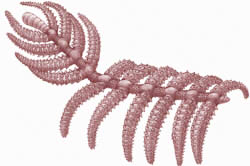
DIANIA:
I've chosen this as our very, very last, because it's not only another extinct one, but has been theorized as one of the earliest known ancestors of all arthropods, believed to have walked along the sea floor and fed upon softer-bodied organisms.
As a Pokemon: being an "ancestral" bug, what if it's not bug type? What if it's just water type or even normal type, but it has an ability that significantly boosts the power of bug moves.
I've chosen this as our very, very last, because it's not only another extinct one, but has been theorized as one of the earliest known ancestors of all arthropods, believed to have walked along the sea floor and fed upon softer-bodied organisms.
As a Pokemon: being an "ancestral" bug, what if it's not bug type? What if it's just water type or even normal type, but it has an ability that significantly boosts the power of bug moves.
